The Historic England Blog


10 Historic Urban Prisons
Discover the history of prisons in England.
Here are 10 of England’s urban prisons that help to tell the story of 250 years of imprisonment.
1. HMP Stafford
HMP Stafford was the brainchild of the pioneering prison architect William Blackburn. Begun in 1787, the original building consisted of a quadrangle with projecting wings similar in design to his prison at Gloucester.

In 1834 a crescent shaped wing was erected, the only example of this plan type in an English prison. Despite major alterations and additions during the following 180 years, parts of Blackburn’s original prison and the crescent have survived.
2. HMP Maidstone
The first stone of the new prison designed by the architect Daniel Asher Alexander was laid in 1810 and in 1819 the first inmates begin to arrive, though work continued until 1822.

The early prison consisted of a large, central tower accommodating the 2 governor offices and a chapel on the top floor, from which 3 cruciform complexes of blocks radiated.
Each prison block was separate from every other one, linked by iron walkways, with wings divided longitudinally to double the number of categories of inmate that could be accommodated separately. A substantial part of the original design has survived despite later alterations and additions.
3. HMP Brixton
In 1819 the Surrey magistrates commissioned Thomas Chawner to build a new House of Correction. He built a large prison arranged in a half octagonal plan with an octagonal governor’s house at the centre to oversee the exercise yards contained within the main wings.

In 1821 six treadmills were installed to power a corn mill in the prison. In the later 19th century the site was used as a female convict prison, then a male convict prison and a military prison, before returning to being a local civilian prison in 1897.
The main wings of the current prison were built during the late 19th and early 20th century.
4. HMP Pentonville
During the 1830s the government recognised that a new form of imprisonment and prison design was required, and looked to the USA for inspiration.
HMP Pentonville received its first inmate in December 1842, and was the first purpose-built prison to implement the model regime, which became highly influential.

Inmates were kept strictly segregated from each other in the wings, chapel and exercise yards, and they passed their sentence in Pentonville in total silence. In plan, four wings radiate out from a central hall from which each storey of each wing could be observed.
The harshness of this initial regime was soon modified, as many inmates were driven insane by the experience.
5. HMP Preston
The prison at Preston was another example of William Blackburn’s designs of the 1780s. However from the early 1840s onwards the prison was gradually transformed by the addition of a series of wings, inspired by HMP Pentonville.

The most striking of these wings is C Wing (pictured), erected in the mid-1860s, potentially by Alfred Waterhouse, the architect of HMP Manchester.
6. HMP Manchester
When HMP Manchester (commonly referred to as Strangeways) opened on 25 June 1868, it could house 744 male and 315 female prisoners in two radial blocks inspired by Pentonville.

A key aspect of these new prisons was heating and ventilation, achieved by boilers warming air in the basements of wings. In most prisons a series of small rooftop towers drew this warmed air through the wings, but at Manchester a tall Italianate chimney served the same purpose.
7. HMP Wormwood Scrubs
HMP Wormwood Scrubs was designed by Sir Edmund Du Cane while Director of Convict Prisons to hold around 1400 convicts, though by 1891 it had become a local prison.

The prison was designed in a new plan form for prisons in Victorian England, with four parallel blocks (one for female prisoners) linked by a low corridor.
As each wing was aligned north to south, this allowed every cell to receive some direct light during the day, an idea that may have been influenced by contemporary hospital planning. The ‘Scrubs’ is most famous for its gate, which was completed by 1885, but it also has the largest church in any prison in England.
8. HMP Nottingham
When Sir Edmund Du Cane became Chairman of the Prison Commissioners, he instituted a major programme of prison closures, and in their place a number of new prisons were built including ones at Dorchester, Shrewsbury, Norwich and Nottingham.

HMP Nottingham was built between 1889 and 1891 to hold 243 inmates, including a small number of female prisoners in their own wing. Inspired by the style and plan of Wormwood Scrubs, this smaller prison had a combined chapel and administration block attached to the front of the male prison, with the main buildings being linked by enclosed walkways.
9. Young Offenders Institute, Aylesbury
The Young Offenders Institute at Aylesbury is another of the Pentonville-inspired prisons built in the 1840s, but during the 1890s it became a female convict prison.

By the early 20th century prison reformers were recognising the need for the specialised treatment of offenders and therefore briefly the prison became home to the State Inebriate Reformatory (SIR) for women erected in 1902-5.
The prison also became the first female borstal and part of the SIR was used to house women undergoing preventive detention, a short-lived form of educational imprisonment that took place after the original sentence had been completed.
10. HMP Birmingham
The prison at Birmingham was designed by the Victorian prison architect Daniel Rowlinson Hill and erected between 1845 and 1849.

Various additions and extensions were made during the following 150 years, but the most striking, and most obvious to the public, is the gatehouse that was built during the mid-1980s. It may echo the shapes used in Victorian gatehouses, but it is much larger, more sophisticated in plan and built using modern materials.
Further reading
Life behind the wire: rare images of Prisoner of War Camps
Gruesome Georgians: Crime and Punishment
Share this:
- Click to share on Facebook (Opens in new window)
- Click to share on Twitter (Opens in new window)
- Click to share on LinkedIn (Opens in new window)
- Click to share on Tumblr (Opens in new window)
- Click to email a link to a friend (Opens in new window)
- Click to share on Reddit (Opens in new window)
1 comment on “ 10 Historic Urban Prisons ”
northallerton has already closed near me, am not sure if durham is closing as well?
Leave a Reply Cancel reply
Discover more from the historic england blog.
Subscribe now to keep reading and get access to the full archive.
Type your email…
Continue reading

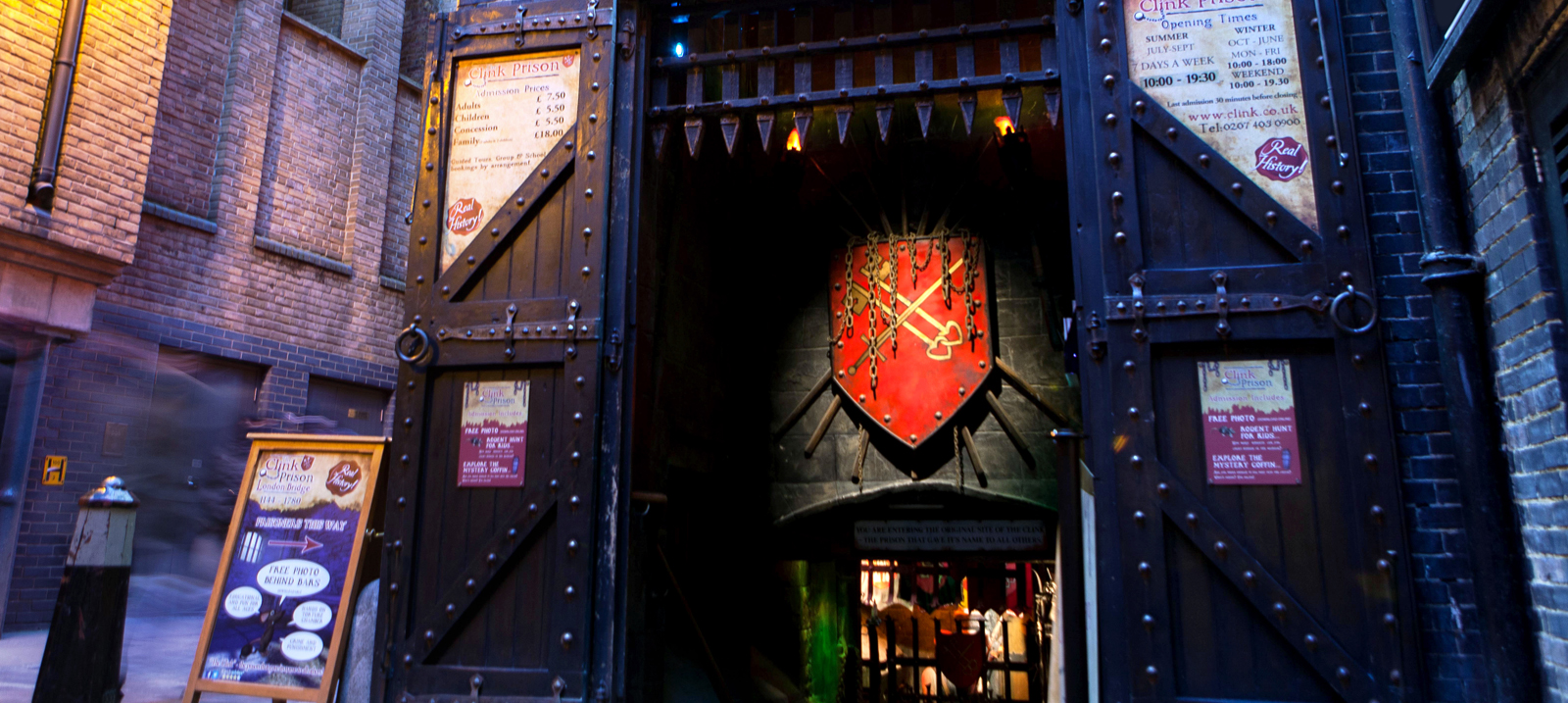
WELCOME TO CLINK PRISON MUSEUM
The Clink Prison dates back to 1144 making it one of England’s oldest and most notorious prisons. Positioned in the heart of modern-day Southwark and built on the original site, The Clink Prison Museum presents the scandalous truth of Old Bankside through a hands-on educational experience. There are opportunities to view archaeological artefacts, experience the sights, sounds and smells of the prison, handle torture devices, and to view and hear all about the tales of torment and many misfortunes of the inmates of the infamous Clink Prison.
Spanning for over 600 years, it witnessed a remarkable amount of social and political change in England, and thus housed a multitude of sinners throughout its existence, including debtors, heretics, drunkards, harlots, and later religious adversaries. Positioned in the heart of modern day Southwark, the prison was situated in an area that has long been associated with more raucous, vivacious and unruly behaviour; it was the louder, ruder and wickeder neighbour to The City, and a place where Londoners sought entertainment.
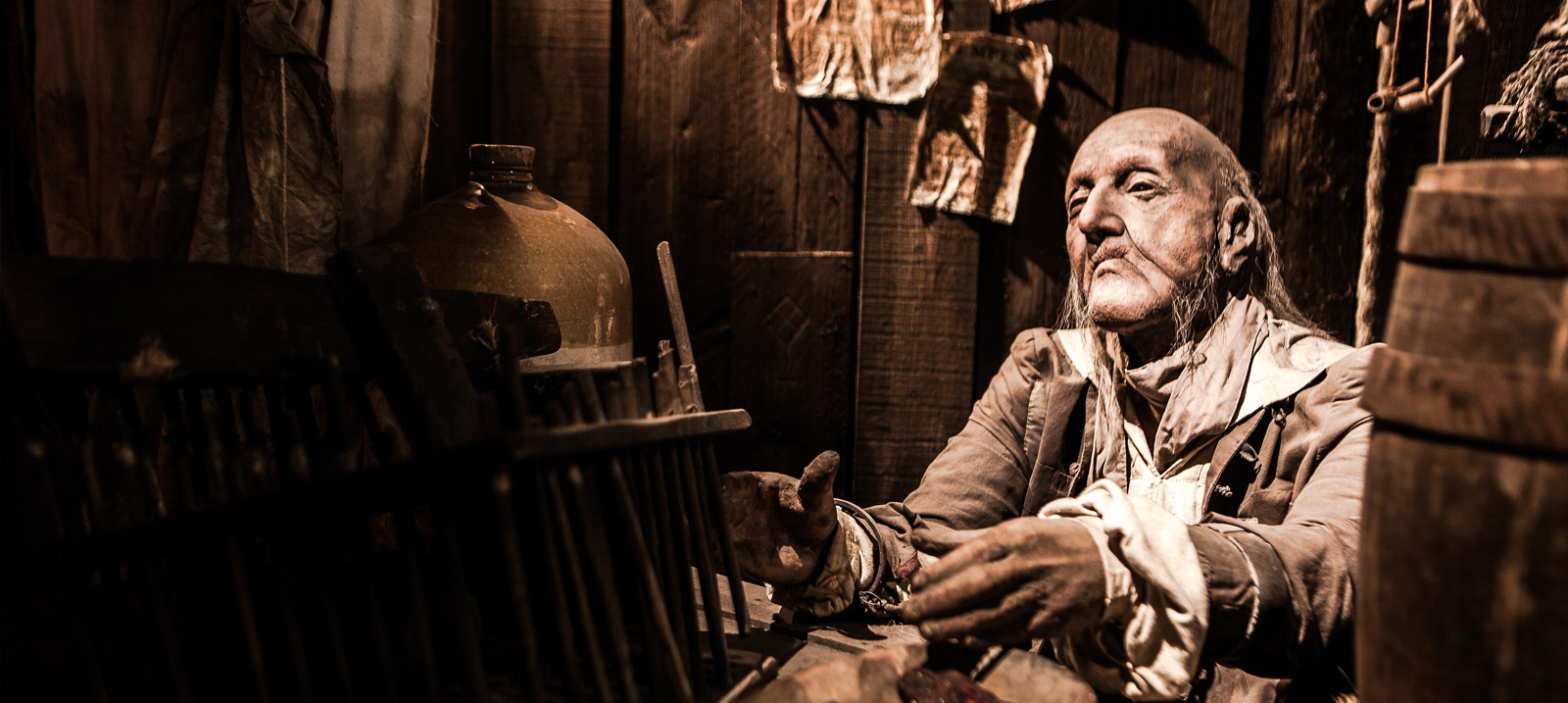
EXPLORE THE PRISON THAT GAVE ITS NAME TO ALL OTHERS!
We are great with kids.

We accept all major credit cards

The Clink Prison Museum | 1 Clink St, London, SE1 9DG United Kingdom [email protected] | 020 7403 0900 terms & conditions | privacy policy | partners Copyright © The Clink Museum Ltd. | All Rights Reserved! The Clink Museum Ltd. registered in England & Wales, registration number 06865379
Please note, unfortunately this museum is NOT wheelchair accessible. Sorry for the inconvenience caused.
- Early Prisons
- Prison Food
- Transportation
- Nationalisation
- Young Offenders
- Convict Prisons
- County Gaols
- Debtors' Prisons
- Detention Centres
- Local Prisons
- Miscellaneous
- Prison Ships
- Bedfordshire
- Buckinghamshire
- Cambridgeshire
- Gloucestershire
- Herefordshire
- Hertfordshire
- Huntingdonshire
- Isle of Wight
- Leicestershire
- Lincolnshire
- Northamptonshire
- Northumberland
- Nottinghamshire
- Oxfordshire
- Staffordshire
- Warwickshire
- Westmorland
- Worcestershire
- Yorkshire, E.Riding
- Yorkshire, N.Riding
- Yorkshire, W.Riding
- Breconshire
- Cardiganshire
- Carmarthenshire
- Carnarvonshire
- Denbighshire
- Merionethshire
- Monmouthshire
- Montgomeryshire
- Pembrokeshire
- Radnorshire
- Aberdeenshire
- Angus (Forfarshire)
- Argyllshire
- Berwickshire
- Clackmannanshire
- Dumfriesshire
- Dunbartonshire
- East Lothian
- Inverness-shire
- Kincardineshire
- Lanarkshire
- Peeblesshire
- Renfrewshire
- Ross & Cromarty
- Roxburghshire
- Selkirkshire
- Stirlingshire
- West Lothian
- Wigtownshire
- Co. Donegal
- Co. Fermanagh
- Co. Kildare
- Co. Kilkenny
- Co. Laois (Queen's)
- Co. Leitrim
- Co. Limerick
- Co. Londonderry
- Co. Longford
- Co. Monaghan
- Co. Offaly (King's)
- Co. Roscommon
- Co. Tipperary
- Co. Waterford
- Co. Westmeath
- Co. Wexford
- Co. Wicklow
- Isle of Man
- Channel Isles
- County Bridewells
- Detention' Centres
- Military Prisons
- POW Prisons
- Town Bridewells
- Bodmin 1782
- Clerkenwell 1862
- Prison Museums
- Citation of content
- Cookie Preferences
- Cookies Policy
- Privacy Policy
Visit a Prison Museum!
Although The Prison Website provides a vast amount of information about prisons, there's nothing like exploring a real prison building to get a first-hand idea of what they were like. The best way to do this is to visit one of the museums now housed in a former prison.
Always check current opening details with each museum when planning a visit.
- Attractions
- Historic Prisons

There have been many prisons in London, the most famous one being the Tower of London
It is possible to visit the Tower of London (admission charge).
Tower of London

The Tower of London is the most popular tourist attraction in London and one of the greatest examples of Norman architecture anywhere in the world.
It was begun by William I around 1066 and built deliberately just outside the City boundary to warn potential troublemakers. It was then extended by a number of monarchs until Edward I, and has been a palace, prison, menagerie, place of execution and stronghold for the crown jewels.
Famous occupants have included Sir Francis Drake, Anne Boleyn (executed by sword), Sir Walter Raleigh and Rudolph Hess during the second world war.
Map and Street Views Nearest underground station: Tower Hill
Newgate Prison

Newgate prison existed on the corner of Newgate Street and Old Bailey for seven hundred years.
The prison was destroyed and re-built several times throughout its history, including during the Great Fire of London and during prison riots.
By 1783, it was London’s main prison and the city’s gallows were moved from Tyburn to Newgate Street.
In 1868, public executions were discontinued and held instead inside the prison.
The prison was demolished in 1904.
Nearest underground stations: St Pauls
Marshalsea Prison

Mostly known as a debtors prison, Marshalsea prison existed in Borough High Street for over five hundred years – closing in 1842.
It was a national prison, second only to the Tower in importance, and became renowned worldwide thanks to Dickens, who wrote about life in a debtors prison in his novels such as Little Dorritt.
Dickens’ father was sent to Marshalsea in 1824 owing a debt of forty pounds.
It is one of the few historic prisons where part of the original buildings remain. You can still see one of its walls and two original gate arches in the yard next to St George the Martyr church.
Nearest underground station: Borough
Bridewell House of Correction

Established as a house of correction in 1556 in a former royal palace (Bridewell), this prison was for housing vagrants and homeless children and punishing petty criminals and unruly women. The prison also contained workrooms and a hospital.
It was largely destroyed in the Great Fire of London and re-built soon after, before being finally demolished in 1863.
All that remains of the prison buildings is the gateway on New Bridge Street at number 14. The rest of the old site is now occupied by the Unilever Building on the corner.
Nearest railway station: Blackfriars
Cold Bath Fields Prison

This large prison in Clerkenwell was also known as Clerkenwell Jail.
It was built in 1794 on the site of what is now the Royal Mail sorting office at Mount Pleasant. Some of the prison wall pillars still remain.
It was renowned for the harshness of its punishments, including enforced silences and solitary confinement.
By the mid nineteenth century, its name had changed to Middlesex House of Correction.
It was closed in 1877 and demolished in 1889.
Nearest railway station: Farringdon
Fleet Prison

Situated on the eastern side of Farringdon Road, Fleet Prison was mainly a debtors’ prison. William Penn was held there in 1707-1709 for debt.
However,the prison also held political and religious prisoners. In 1601, the poet John Donne was imprisoned in it for marrying a woman without her father’s consent.
The prison was destroyed in the Great Fire of London and soon after, re-built. However, it no longer exists today.
There was large scale prison corruption, with prisoners being allowed out of the prison on payment of fees to the keeper, and those who were unable to afford the fees, being forced to share crowded, lice-ridden cells.
Dickens described the prison in Pickwick Papers. It was finally closed down in 1842.
Clerkenwell House of Detention

There has been a prison on this site since 1616, although the only remaining part of it – its tunnels – were built in 1844.
It was largely used as a detentional prison and an estimated 10,000 people a year passed through its gates.
The prison was demolished in 1890, but an entire underground section survived and lay undisturbed until the bombs of the Blitz saw it reopened as an air-raid shelter.
The site of the prison is now occupied by the Hugh Myddleton School building (and partially converted into residential flats).
However, it is possible to access the tunnels from Clerkenwell Close, behind St James Church.
Nearest underground stations: Farringdon, Angel
Gatehouse Prison

Built in 1370, it was originally part of a prison which existed in Westminster Abbey’s gatehouse. Sir Walter Raleigh was imprisoned in it on the eve of his execution at the Tower of London in 1618.
It is believed that the saying, “stone walls do not a prison make, nor iron bars a cage” was written here by the poet, Lovelace, in 1642. In 1689, Samuel Pepys was imprisoned in it.
It was demolished in 1776 and the site is now occupied by Westminster School’s Crimean War Memorial (the tall column) which stands in front of Westminster Abbey, in Broad Sanctuary.
Nearest underground station: Westminster
King’s Bench Prison
This prison originally stood on the east side of Borough High Street, and in 1755 it moved to a larger area at St George’s Fields.
The majority of prisoners were debtors, and they were often joined by their families. Dickens wrote about it in David Copperfield, with Mr Micawber being imprisoned in it for debt.
In 1828, the prison was described as “the most desirable place of incarceration in London” – the courtyard was full of traders and there were a large number of gin shops on site. Rich prisoners even had a regular cook to prepare their meals. By the 1870’s the prison had closed.
Clink Prison

This was a small prison connected to Winchester Palace on Bankside. First mention of it is in 1509 and it was destroyed in 1780.
It was for those who committed offences on Bankside and in the nearby brothels, which were controlled by the Bishop of Winchester.
Prisoners included both Protestant and Catholic prisoners of conscience, and towards the end of its existence it was also a debtor’s prison.
The Clink Prison Museum, in Clink Street, sits on the site of the original prison.
Nearest underground station: London Bridge
Horsemonger Lane Jail

Visiting Oxford > What to See > Historical Places
Oxford Castle & Prison
Oxford Castle is a partly ruined Norman medieval castle on the centre of Oxford. The castle then became a prison, which closed in 1996. Today, you can visit this fantastic location and enjoy a variety of activities – including a climb to the tower, a descend into the crypt, and a fascinating historic mound. Plus, stories about England’s rulers and one of the best gift shops in the city!
What's the History of Oxford Castle?
Oxford Castle was originally a wooden motte and bailey castle . The wood was replaced by stone around the late 12th or early 13th century. Although Oxford Castle played a crucial role in the conflict of the Anarchy (a civil war in England and Normandy between 1138 and 1153), its military value decreased in the 14th century and the place became a prison and county administration building.
In the aftermath of the English Civil War (1642–1651), Oxford Castle underwent significant transformations reflective of the conflict’s impact on the region. The castle, originally constructed for strategic purposes, found itself at the epicenter of political and military upheavals during this period. As a key Royalist stronghold, it played a pivotal role in the defense of Oxford, which served as the Royalist capital during parts of the war.
Who Built Oxford Castle?
It’s believed that Oxford Castle was built by the Norman baron Robert D’Oyly the elder between the years 1071 to 1073. D’Oyly had accompanied William the Conqueror on his invasion of England. After their victory, William granted him extensive lands in Oxfordshire.
The castle was built to dominate the town, which had suffered considerable damage during William’s campaign. D’Oyly soon became the foremost landowner in Oxfordshire and was given a hereditary royal constableship for Oxford Castle.
Can’t see this widget? Use this link instead.
The Original Motte and Bailey Castle
The original wooden castle was a large motte and bailey , situated on a raised area of ground. The motte was originally about 60 feet (18 m) high and was made from layers of gravel strengthened with clay facing. This structure was replaced by stone in the late 12th or early 13th century.
The classic motte and bailey design typically consisted of a raised earth mound (the motte) crowned with a wooden tower or keep, providing an elevated vantage point for strategic observation. Adjacent to the motte was an enclosed courtyard (the bailey) surrounded by defensive walls and often housing additional structures like living quarters, stables, and workshops. This particular motte and bailey Castle definitely played a pivotal role in the city’s defense. During this period, such castles were essential for asserting control over territories, serving as military strongholds and administrative centers.
St George’s Tower, built of coral rag stone, was the tallest of the castle’s towers. Some believe it’s Saxon in origin, as it doesn’t seem to belong within the outer defences of an earth-and-timber castle.
Oxford Castle & Prison Reviews
A Time-Traveler’s Delight
“As a self-proclaimed time-travel enthusiast, my visit to Oxford Castle and Prison was nothing short of exhilarating. The echoes of the English Civil War resonated through the ancient stones, transporting me to an era where kings and rebels clashed. The scars of battle were vividly apparent, and the prison cells whispered stories of a bygone time. The immersive experience was like stepping into a living history book, and I left with a newfound appreciation for the castle’s pivotal role in shaping England’s past.” JD
Ghost Hunter’s Paradise
“Searching for a spine-tingling adventure? Look no further than Oxford Castle and Prison! As a seasoned ghost hunter, this historic site surpassed my expectations. The eeriness of the prison cells and the haunted tales that linger within the castle walls sent shivers down my spine. Whether it was the chilling stories of former inmates or the inexplicable creaks in the darkness, every corner held the promise of a ghostly encounter. A must-visit for thrill-seekers and paranormal enthusiasts!” Adam
Medieval Feast for the Senses
“For a medieval feast for the senses, Oxford Castle and Prison is a hidden gem. The ambiance of the castle courtyard set the stage for a banquet fit for royalty. The immersive medieval banquet experience, complete with period costumes and authentic dishes, transported me to a time of knights and maidens. The live entertainment, featuring jesters and minstrels, added a whimsical touch. It’s not just a tour; it’s a culinary and cultural journey through the medieval ages. Five stars for an enchanting evening!” Miranda
How do you Visit Oxford Castle?
Oxford Castle & Prison is open to the public every day of the week. There is an optional 101 step climb with a fantastic panoramic view of the city, a candle-lit crypt, 18th century prison cells, and several events throughout the year.
It’s generally recommended to book a ticket in advance, which you can do though their website . They offer regular guided tours and children can visit for free.
More Historical Places

Carfax Tower
Carfax Tower, in Oxford, is a 23-meter-high bell tower that used to belong to a 12th-century church. Here’s how to visit it (and why!).

University Church of St Mary the Virgin
University Church of St Mary the Virgin is actually from where Oxford University grew, and an un-missable spot if you’re visiting the city.

24-26 Cornmarket Street, Oxford
24-26 Cornmarket Street, Oxford is a timber-framed building built in the late 14th century. It belonged to a wine merchant and was an inn.

Mob Quad in Merton College
Mob Quad in Merton College is probably the oldest quadrangle in Oxford. The quad is so old, it actually doesn’t have any chimneys.

Christ Church Cathedral
Christ Church Cathedral is perhaps the most stunning college chapel in Oxford. It was built as a place of worship in the late 12th century.
Museums & Art Galleries

Antiques on High
Antiques on High is an antiques and art shop from Oxford founded in 1997 and open seven days a week. It has won several awards.

Aidan Meller Gallery
Aidan Meller Gallery is one of Oxford’s longest-established specialist art galleries. They showcase modern, contemporary and old masters.

Christ Church Picture Gallery
Christ Church Picture Gallery is an art museum holding an important collection of about 300 Old Master paintings.
Parks & Meadows

Shotover Country Park
Brasenose Wood is a woodland park featuring quiet walking paths and diverse flora. It’s also part of a larger nature reserve in Oxford.

Crocodiles of the World
Crocodiles of the World is a unique and fascinating attraction located in Oxfordshire and dedicated to crocodiles and their relatives.

Cotswold Wildlife Park and Gardens
The Cotswold Wildlife Park and Gardens is a renowned zoological collection in Oxfordshire. Here’s how to visit from Oxford.
Things to Do in Oxford

The Old Parsonage Hotel
The Old Parsonage Hotel is one of the best-ranked hotels in the city and dates back to the 17th century. Here’s how to visit.

The Randolph Hotel
The Randolph Hotel, situated in the heart of Oxford, stands as a distinguished landmark of the city, attracting guests from around the world.

Westgate Oxford
Westgate Oxford has more than 100 stores featuring prestigious luxury brands and beloved high-street choices.

Barefoot Jericho
Barefoot offers homemade cakes, pastries and bread, delicious coffee for eat-in or takeaway in the neighbourhood of Jericho, in Oxford.
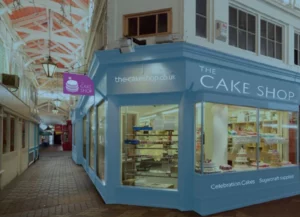
The Cake Shop
The Cake Shop offers ready-made designs and bespoke masterpieces and has been trading since 1986 in Oxford’s Covered Market.
Everything about Oxford and its surrounding areas, including places to see, things to do, and information about all the colleges, libraries, and museums.
As an Amazon Associate, I earn from qualifying purchases.
www.OxfordVisit.com © 2024 – Privacy Policy
Privacy Overview
We've noticed that you're using an out of date browser. We recommend that you update to the latest version to enhance your browsing experience.
We've refreshed our website design so things may look a little different if you've been here before. We'll be making more improvements soon so watch this space.
Availability Search for Inveraray Jail
Terms & conditions.
This booking system and any information appearing on this page relating to the availability of any accommodation is provided by third parties and not by VisitScotland. It is intended to provide real time availability information relating to accommodation which is also provided by third parties. You may use this booking system to place direct bookings with third party accommodation providers. Any booking you make will not be placed with VisitScotland and we will have no liability to you in respect of any booking. If you proceed to make a booking you will leave our Website and visit a website owned and operated by a third party. VisitScotland does not have any control over the content or availability of any external website. This booking system and any information appearing on this page is provided for your information and convenience only and is not intended to be an endorsement by VisitScotland of the content of such linked websites, the quality of any accommodation listed, or of the services of any third party.
Inveraray Jail
Step back almost two centuries and discover the stories of the real men, women and children who were tried and served their sentences in this prison.Listen to dramatic true tales from the Jail's characters brought to life with our FREE AUDIO GUIDES.
Come and experience one of the finest and best preserved Jail and Courtroom complexes in the world. You are free to explore this unique collection of historic buildings brought to life by real characters from the Jail’s past and FREE AUDIO GUIDES AVAILABLE IN SIX LANGUAGES . Step back in time and experience the true stories of what life was like for the men, women and children – some as young as seven – who were tried and locked up here all those years ago. Do view our videos and our reviews on TripAdvisor .
Torture, Death and Damnation
Your journey starts in the Torture, Death and Damnation exhibition highlighting the many forms of punishment and deterrents used before the days of civilised courts and imprisonment was adopted. Discover how criminals were branded with hot irons or even their ears nailed to a post! Try out the thumbscrews used to twist down and inflict pain.
County Courtroom
Move through time and enter the spectacular courtroom. Take your seat alongside the witnesses and listen to extracts from actual trials held in this room over 150 years ago. Imagine that you were in the dock, facing time in Jail. Feel the tension as the sentence is passed. Now it is time to make your way down to the prisons…….
Walk the narrow corridors, see the cramped, overcrowded cells and be shocked at the young children in a cell next to the lunatic. Meet and talk to the warder, matron and prisoners and hear their stories.
Compare the old prison with the new, built in 1848, a model prison in its day. Try out the hammocks and the wooden beds, get strapped onto the Whipping Table or take a turn on the Crank Wheel. Discover the gripping stories of many of the prisoners held here – from being transported to Australia for trivial crimes to being sentenced to serve time for stealing a turnip! Visit our modern day cell is present day prison life too easy? Uncover amazing facts in every cell.
Airing Yards and Prison Grounds
Explore the prison grounds, meet the highland cow used to provide the milk, get locked up in the Airing Yards used for the prisoners exercise, visit the Jail kitchen and search over 4,000 prisoner records.
Transport and Parking
- Public Parking Nearby
- Coach Parking
- On Public Transport Route
- Pets Welcome
Accessibility
- Partial wheelchair access
- Accessible Parking Or Drop-off Point
- Level access from entrance to reception
- Partially suitable for visitors with limited mobility
- Baby Changing Facilities
Payment Methods
- Credit Card
- Coastal Location
- Sea/Loch View
Languages Spoken
Cookies are required to view this content. Change your preferences at Manage Cookie Settings
The content of many of our web listings is provided by third party operators and not VisitScotland. VisitScotland accepts no responsibility for (1) any error or misrepresentation contained in third party listings, and (2) the contents of any external links within web listings ((1) and (2) together hereinafter referred to as the "Content"). VisitScotland excludes all liability for loss or damage caused by any reliance placed on the Content. The Content is provided for your information only and is not endorsed by VisitScotland.
What's Nearby
Accommodation, attractions, food & drink, terms and conditions.
- Skip to content
Discover Cotswolds
Your ultimate guide to the Cotswolds
The Old Prison
Where : at the Old Prison, Fosse Way, Northleach, Gloucestershire GL54 3JH
The grade II* listed Old Prison, is a fascinating 18th century building and now a unique historic visitor attraction in the Cotswold market town of Northleach . The centre was previously also home to the Cotswolds Conservation Board , and the Cotswolds Dry Stone Walling Academy .
The prison itself is still open to the public as an attraction and is run by the Friends of the Cotswolds. For more information visit: https://friendsofthecotswolds.org/the-old-prison/
Cotswolds Discovery Centre
The Cotswolds Discovery Centre was located at the Old Prison until 2018 but is no longer operating. It was the visitor centre for the Cotswolds Area of Outstanding Natural Beauty (AONB), a place where you could learn and discover more about this beautiful and unique protected landscape and how people have helped shape it over thousands of years.
Learn about the Cotswold landscape and the heritage of its people and buildings
Through imaginatively designed information displays you will learn how geology has shaped the landscape; when dinosaurs first roamed the area; and how the wealth of the area came as a result of the ‘golden fleece’ of the Cotswolds sheep.
You will also find inspiration for great places to discover and visit across the Cotswolds AONB such as historic and sites, gardens, wild flower grasslands, ancient woodlands plus the Cotswold Way National Trail which runs the length of the Cotswolds escarpment providing sweeping views for miles..
Explore the fascinating Lloyd Baker Rural Life Collection
Housed within the grounds of the Cotswolds Discovery Centre is the unique Lloyd Baker Rural Life Collection – a wonderful display of historic agricultural and farming machinery. This fascinating and nationally important collection of farm wagons, carts and implements along with two shepherds huts, will take you back in time to the days when the land was toiled by man and beast and tractors hadn’t yet been invented.
Glimpse into life in a 19th century house of correction bursting with history
Walk inside the chilling cells and capture the feeling of being locked inside!
A visit to the Old Prison offers you a unique glimpse into life in a 19th century house of correction. Built in the 1790s, this was once a fine example of a model prison used to inspire better care and rehabilitation of prisoners throughout Britain and further afield. It even served as a blueprint for London’s Pentonville Prison.
Over the years the building has seen many changes of use including a police station, petty sessional court and tramp station. You can still see one of the original cell blocks built in 1844 along with the historic court room which was in use right up until the 1970s.

Take a tour
There is a self guided tour of the Old Prison available to help you find your way around.
Grab a bite to eat
Relax in the Old Prison cafe and enjoy locally sourced delicious home made food
The Cafe serves home made food, prepared from locally sourced fresh ingredients. We offer a wide range of delicious breakfasts, light lunches and afternoon teas, along with speciality teas, coffee and soft drinks.
There is outdoor seating available in the family friendly courtyard where you can relax and enjoy your visit, or get snugly and warm in front of the wood burning stove. They use local suppliers wherever possible to provide the best quality raw ingredients in order to make their home made specials including:
- organic Cotswold Brie from Upper Slaughter
- apple juice and chilli oils from Cheltenham
- fresh meats and salamis from Cirencester
- and chutneys and pickles from Moreton-in-Marsh
They make seriously good food with a friendly welcome to all, whether you are arriving by car, bus, on two wheels, or foot or with your dog. The cafe is licensed and is also available to hire for your own private party or event.
If all this talk of food is making you hungry, read about some must visit restaurants in the Cotswolds .
The Cotswold shop within the cafe stocks a selection of local food and drink products and a range of unique hand-made gifts and art works. the shop also stocks maps, guides and books to help you explore the Cotswolds further.
Looking for more inspiration? Check out our guide on things to do near Moreton in Marsh .

NEW TO PRISON: ENTER THE CAPTIVATING REALM OF STORYTELLING

NIGHT BEHIND BARS - THE ULTIMATE SLEEPOVER

GUIDED TOURS - A FASCINATING NO-HOLDS-BARRED TOUR
As featured in
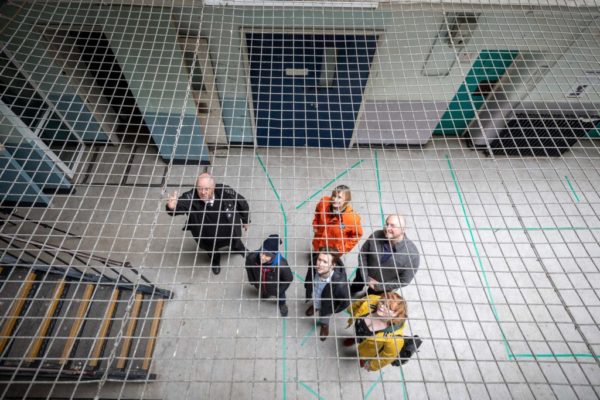
Guided Tours
A guide with an encyclopaedic knowledge of the prison's history, shines a light on what life was like for prisoners through a no-holds-barred tour.

The Cell Escape Room
The Cell Escape is a fully immersive, state-of-the-art escape room experience, where you get to do the time without committing the crime! Experience the pulse racing, mind-manipulating, adrenaline-charged rush of ‘The Cell Escape Room’.
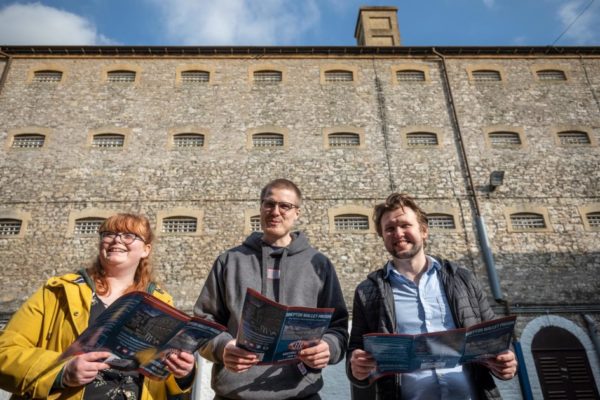
Self-Guided Tour
Explore the whole prison at your leisure, take photos and CELLfies as you soak up the atmosphere of this amazing prison.

Paranormal Investigations
Led by paranormal professionals and using state-of-the-art equipment in your search, you'll spend the night ghost hunting within the haunted prison.
NEWS & ARTICLES
Easter holiday activities at shepton mallet prison.
Prepare for an unforgettable Easter adventure at Shepton Mallet Prison from March 29th to April 14th! Embark on a journey through time as we unlock the fascinating secrets of the past in a celebration of Easter like no other. Egg-citing Easter Fun: Kids aged under 16 are in for a treat with our thrilling Easter […]
Unique Venue Hire in Somerset | Shepton Mallet Prison
Your Premier Choice for Unique Venue Hire in Somerset Nestled in Somerset, Shepton Mallet Prison offers a venue like no other. With a history spanning 400 years, it’s now a hub for unforgettable events. From social gatherings to grand celebrations, its four-acre space provides endless possibilities. Guided tours, escape rooms, and Ghost Tours ensure every […]
Email Signup
- I'd like to opt-in to receive updates, and offers. You can unsubscribe at any time.

Opening Hours
Mon-Sun: 10am-5pm
Shepton Mallet Prison, Frithfield Lane, Shepton Mallet, Somerset, BA4 5FQ
© Copyright 2024 | Shepton Mallet Prison is part of Cove Group Ltd.
Designed & Built by Reech
Cookies on GOV.UK
We use some essential cookies to make this website work.
We’d like to set additional cookies to understand how you use GOV.UK, remember your settings and improve government services.
We also use cookies set by other sites to help us deliver content from their services.
You have accepted additional cookies. You can change your cookie settings at any time.
You have rejected additional cookies. You can change your cookie settings at any time.
- Crime, justice and the law
- Prisons and probation
Visit someone in prison
Use this service to request a social visit to a prisoner in England or Wales. There’s a different way to book a prison visit in Northern Ireland or a prison visit in Scotland .
To use this service you need the:
- prisoner number
- prisoner’s date of birth
- dates of birth for all visitors coming with you
If you do not have the prisoner’s location or prisoner number, use the ‘Find a prisoner’ service .
You can choose up to 3 dates and times you prefer. The prison will email you to confirm when you can visit.
The prisoner must add you to their visitor list before you can request a visit. This can take up to 2 weeks.
Request a prison visit
Visits you cannot book through this service.
Contact the prison directly if you need to arrange any of the following:
- legal visits, for example legal professionals discussing the prisoner’s case
- reception visits, for example the first visit to the prisoner within 72 hours of being admitted
- double visits, for example visiting for 2 hours instead of 1
- family day visits - special family events that the prison organises
Help with the costs of prison visits
You may be able to get help with the cost of prison visits if you’re getting certain benefits or have a health certificate.
Related content
Is this page useful.
- Yes this page is useful
- No this page is not useful
Help us improve GOV.UK
Don’t include personal or financial information like your National Insurance number or credit card details.
To help us improve GOV.UK, we’d like to know more about your visit today. We’ll send you a link to a feedback form. It will take only 2 minutes to fill in. Don’t worry we won’t send you spam or share your email address with anyone.

- Opening Times and Prices
- How to Find Us
- Know Before You Go
- Things to do in Oxford
- Access Information
- General Booking Terms and Conditions
- Birds of Prey
- The Medieval Mystery
- The Oxford Shakespeare Festival
- Ceilidh in the Castleyard
- Victorian Murder Mystery & Dinner
- Private Evening Tours
- Jailbreak Escape Room
- Murder Mystery Events
- Spectre Ghost Tour
- Plan Your Visit
- School Trip Booking Form
- What Schools Say about Oxford Castle & Prison
- School Booking Terms and Conditions
- Group Visits
- Group Booking Form
- Language Schools
- Group Terms and Conditions
- Private Tours
- Christmas Parties
- Private Venue Hire
- Ghost Hunts
- Outdoor Hire
- Hire Terms and Conditions

Top Prisons Open to Visitors in the UK
You’re going to jail! It’s not something everyone wants to hear, however, you don’t have to be a criminal to visit a UK prison! There are many historic and operating jails that allow you to visit as a guest. Visiting a prison isn’t as scary as it sounds, they are a great way to learn about the history of wherever you are visiting. And in most cases, a towns’ prison is often the epicenter of some of the best stories. Read on for the top prisons open to visitors in the UK:
6. Bodmin Jail, Cornwall http://www.bodminjail.org/
Originally built for King George III in 1779, this visitor experience is set over six floors! This fascinating building, steeped in both social and architectural history, offers visitors an amazing insight into Cornish penal life over the centuries.
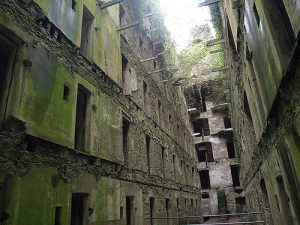
5. York Castle prison http://www.yorkcastlemuseum.org.uk/exhibition/13/
Part of York Castle Museum, the prison exhibition is housed in 18 th century prison buildings. Visitors will get a flavour of what life was really like in the original cells and see some of the most infamous inmates brought to life.
4. Oxford Castle & Prison
Take a guided tour and discover the 1,000-year history of Oxford Castle & Prison. Initially, a Motte and Bailey Castle that transformed over time into a prison. This building is vital to the development of the city of Oxford… And not to mention, housing the university’s drunken students!
Book your tour today
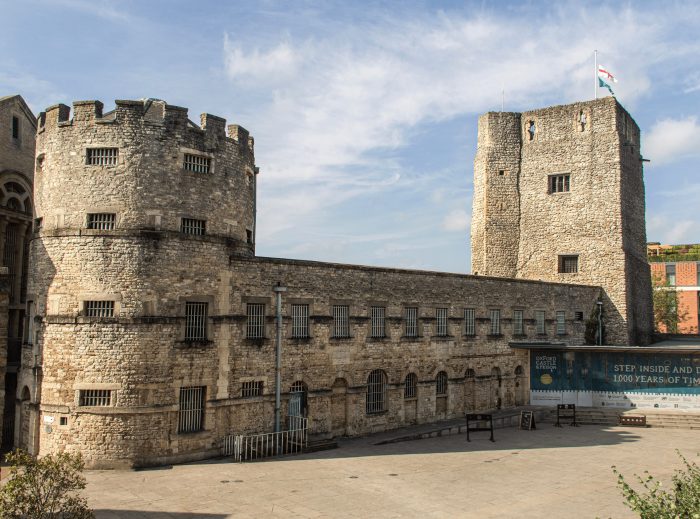
3. Crumlin Road Jail, Belfast http://www.crumlinroadgaol.com/
The Crumlin Road Gaol dates back to 1845 and like HMP Oxford Castle, only closed its doors as a working prison in 1996. Explore over 150 years of history with a Guided Tour of Belfast’s Infamous Prison.
2. The Clink, London http://www.clink.co.uk/
The Clink Prison Museum is built upon the original site of The Clink Prison, which dating back to 1144 was one of England’s oldest and most notorious prisons. Visitors will learn all about the scandalous truth through a hands-on educational experience, with the opportunity to view architectural artefacts, handle torture devices, and hear all about the tales of torment and many misfortunes of the inmates of the infamous prison.
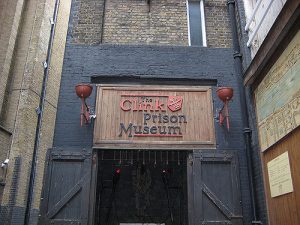
1. Galleries of Justice, Nottingham http://www.galleriesofjustice.org.uk/ England’s history of Crime and Punishment is a shocking one. As are the sinister and grim stories of Nottingham’s own outlaws which are brought to life in the building where they were judged imprisoned and executed. To capture and explain this gruesome history, visitors to the museum of Crime and Punishment will explore exhibitions, and experience audio and performance-led tours set in Nottingham’s old courthouse and gaol.
If you would like to find out more about one of the top prisons open to visitors in the UK (us!) then you can follow our social media channels: Facebook , Twitter and Instagram .
Photo credits:
Bodmin Jail – credit to Jon Blathwayt , used under the Creative Commons attribution license
The Clink – credit to Lisa Tozzi , used under the Creative Commons attribution license (as above)

- PR & Media Centre
- Work with us
- Privacy & Cookies
- Booking T&Cs
- Procurement Policy
- Sustainability Policy
- Enable Recite
Oxford Castle & Prison 44-46 Oxford Castle, Oxford OX1 1AY
Heritage Projects (Oxford Castle) Ltd Registered in England No: 5763243 Registered Office: St. Edmund's House, Margaret Street, YORK, YO10 4UX

Privacy Overview
Photo: Mark Wheaver
Our history.
Over the years the Old Prison has had different roles to play in rural life in the Cotswolds. Each change has reflected developments in society and the legal system.
Before Reform
Prison Reform saw the building of new prisons and houses of correction across the country, starting in Gloucestershire. Before reform the majority of crimes were punishable by either deportation to the colonies or death; even for petty crimes such as stealing anything worth more than 12 pence.
Those not deported or executed would find themselves incarcerated. Each county had a county “Gaol” and also a number of “Bridewells” or Houses of Correction. Gaols were for criminals and Bridewells for vagrants and idle persons. The conditions in both were terrible; damp, unhealthy, filthy and over-crowded. All prisoners were mixed up together whether man, woman or child, regardless of crime, conviction or health.
John Howard
It was philanthropist John Howard who reported on the state of prisons in 1777, condemning the system and calling for change. His writing opened the eyes of the country to how dreadful the conditions were as well as how broken the system was in England, ultimately leading to the Penitentiary Act of 1779.

Reported Conditions
Prison Keepers demanded fines from new arrivals and refused to release them at the end of their sentence until these fines were paid
People who had got into hard times and owed money were called “Debtors”. They were imprisoned with the general population of the Gaols and Bridewells and had to buy their food, drink and clothing from the Keeper.
Most Debtors lived in rags and starved if family, friends or even other inmates didn't help them survive.
Female prisoners were housed alongside male prisoners resulting in many pregnancies and babies being born in prisons
All prisoners were made to wear "fetters." These chains and manacles stopped them from escaping unsecure prison buildings.
Overcrowding resulted in filthy, damp and unsanitary living conditions which were crawling with vermin.

Campaign for Change
Sir George Onesiphorus as High Sheriff of Gloucestershire, was responsible for its prisons. Prompted by John Howard’s report, he visited the Gaol at Gloucestershire and was shocked by what he saw. He began a campaign for a new prison system for the county siting the need for a modern prison system to support the rehabilitation of prisoners.
Photo: Philip Watson
He successfully presented his case to the Grand Jury, Magistrates and other Noblemen and Gentlemen of Gloucestershire and it was agreed in October 1783 that the new prisons would be built. The “Gloucestershire Act” was passed in parliament to allow the new prisons to be built providing meals and clothing at cost to the county rate. It enacted that prison officers should enforce decent behaviour, cleanliness and temperance and ensure just and humane treatment.

Building Begins
The Old Prison was designed by architect William Blackburn who had gained prominence from the 1779 Penitentiary Act as well as also winning first prize in a competition for prison design. Sir George was appointed to design the Old Prison in Northleach as well as the County Gaol in Gloucester.
Originally called the “House of Correction at Northleach”, the Old Prison was built in a significant location on the crossroads of two major roads. The scattered towns and villages of the north Cotswolds were accessible as well as Oxford and London to the east and Cheltenham and Gloucester to the West.
Sir George wanted a a secure building so inmates did not have to be fettered, along with fresh air and running water to reduce prison disease and ill health among the inmates. Segregation by class of prisoner was also a key requirement. Blackburn's design was for an enclosed prison and compound in an irregular hexagon shape, surrounded by high walls which were originally 7.5 meters tall.
The original building included;
A Keeper’s House
A 3-storey central Blockhouse
2 wings of two-storeys connecting this centre block
2 corner blockhouses
Cells were small, only 1.8 meters by 2.4 meters. Each prisoner would have both a day and night cell on separate floors. The little river Leach was diverted by a few meters to flow under the rear security wall of the prison. Water was pumped by prisoners in the exercise yard as being used to power the mill.
An exercise yard was overseen from the Keeper's House and was sectioned by wooden fencing to segregate the different classes of inmates. Sadly William Blackburn died in 1792 before he saw his plans materialised.
The Early Years
The prison finally opened in 1792 and ran according to Sir George’s vision until 1823. Prisoners were given meaningful work, they were unfettered, segregated, fed and clothed and generally well looked after. Life of course was not easy in the Old Prison, but it was a huge improvement to what came before it.
On arrival, all prisoners were received in the reception area. Here they were ordered to bathe and given clean clothes in the form of the prison uniform. After 1808 when vagrants* were accepted at the prison, they had their clothes burnt, their heads and beards shaved and bodies deloused before being given a hot bath and fresh clothes.
Each day prisoners were provided with two hot meals. Those that worked more manual jobs were given extra rations.
There were 5 classes of prisoner and the yard and cells were segregated according to class:
Class 1; The “most atrocious” males
Class 2: 1st time offenders
Class 3: Men and boys imprisoned for not paying fines or being unable to pay surety
Class 4: Women and girls
Class 5: “Vagrants* in foul and filthy state”
Work and pay differed by class too. Any craftsmen could work at his craft and be paid. Expectations and pay for work differed by class. Class 1 prisoners undertook hard labour often without pay and Class 4 prisoners worked in the Keeper’s House, the laundry and the garden.
*A vagrant was a homeless person
.jpg)
Crimes & Convictions
Until the formation of Petty Sessions Courts, Magistrates could send offenders brought to them by a gamekeeper or local voluntary constable straight to prison. They would be marched to the Old Prison and handed over to the Keeper with a note from the Magistrate saying how long they had to be imprisoned and for what offence. Magistrates would also meet in twos or threes to hold summary hearings.
The Old Prison was designed to hold 37 prisoners. However, records show that the average imprisonments in one year between 1792 and 1816 was 46. With sentences being an average of 2-3 months, it is clear that there would have been times when the prison was almost empty and it would rarely have been full. By far the most common crimes during this period were petty theft, breach of contract and vagrancy.
Rehabilitation & Punishment
Following the death of Sir George Onesiphorous Paul in 1823, the treatment of prisoners in the House of Correction changed drastically. Only three months after Sir George passed, magistrates began to introduce a form of hard labour.
In 1823 a hand winch was introduced. Men turned the handle to grind corn on a millstone. This was then replaced in 1827 with a treadmill as the Magistrates looked for an even more punishing tool for the prisoners. The treadmill had steps 8 inches deep and inmates were made to climb for 16 minutes at a time, before returning to the yard to walk for 8 minutes and then back to the treadmill again. This would be repeated for the whole work-session with men climbing between 10 and 12 thousand feet a day.
.jpg)
Treatment of Children
The Factory Act of 1833 made it illegal for children under 9 to work. It also required all children between 9 and 13 to be educated for 2 hours a day. Children under 9 were no longer imprisoned as they could not work. And in 1844 the top floor of the central block became a class room for children between 9 and 13.
Single Mothers
In an attempt to deal with the “problem” of single women having children, The Poor Act of 1834 was passed. This prevented unmarried mothers from claiming poor relief from their parish. The act also removed all financial responsibility from fathers for their children, as the government tried to dissuade unmarried women from having children. Under law, unmarried mothers who couldn’t support themselves became vagabonds and were imprisoned by magistrates.
The Order Book in the Apothecary’s Journal at the Old Prison makes regular references to women and children. Effectively the female cell block was a nursery for the poor as working without support or childcare was almost impossible.
_edited.jpg)
The Mill House
The Magistrates were still not happy that their original treadmill was working the prisoners hard enough. They constructed a new building to house the treadmill – a Mill House that was later converted into the Sergeant’s House. The mill machinery was driven by a shaft through the north wall rotated by the prisoners at the tread wheel. You can still see the arch of the mill from the café today.
Government Enquiry
Following the death of a former inmate shortly after his release, the Magistrates faced a government enquiry into the conditions at the Old Prison in 1842. The enquiry concluded that there were many issues at the Old Prison; ventilation, warmth, quality of medical care were all lacking particularly in the Block House and Female Ward at the north of the building.
As a result, a new cell block for female prisoners was constructed in 1844. The cells were bigger, they included a toilet, basin and heating system that was used throughout the other building.

The End of the Correctional House
The growth of the railway in Britain was changing the country. In 1838, 500 miles of railway existed. By 1848 there were 5,000 miles of railway and it was still increasing and would double again within 10 years. By 1857, railways had quickly spread across the Cotswolds linking small towns and villages with larger towns and cities in the county and beyond. This changed how people lived and worked. It was now much cheaper and easier for Magistrates to travel between courts, and also for offenders to be transported to Gloucester for trial and sentencing. And so, the decision was made to close the Old Prison in 1857 as it was no longer financially viable to keep the rural prison open.

Petty Sessions Court
The government had established Petty Sessions Courts in England in 1828. Three were in operation locally in Northleach, Stow-on-the-Wold and Moreton in Marsh. When the Old Prison closed as a House of Correction, the Northleach Petty Sessions Court in town relocated to the Old Prison. The Keeper’s reception room was repurposed as a courtroom which still exists today.
The established procedure was for the accused to be brought before the local Justice of the Peace for an initial interview. The offender would then be sent to a Petty Sessions Court to receive summary justice. The maximum sentence that could be imposed by a magistrate was 2 years and the court would normally be presided over by three Magistrates assisted by a clerk. For more serious crimes the interviewing Magistrate would send the accused to the Quarter Session where they would face a magistrate and jury before sentencing, including death and deportation.

County Police Station
In the same year, the Old Prison also became a County Police Station for Gloucestershire County Constabulary. The Building was altered between 1857 and 1859 for its new role. Gloucestershire had created a paid police force in 1840 based in Stow-on-the-Wold. When the Old Prison became available the growing force decided to move in and make the Old Prison their main police station for the North Cotswolds.
The police force made some adaptations to the Old Prison to make it fit for purpose. Extensions were built creating two apartments for both the Superintendent and Superintendent of Tramps along with their families. The Mill House was converted into the Police Station complete with accommodation for the Superintendent of Police and his family, while the old women's block became remand cells.
After the Second World War, Northleach was gradually becoming less of a commercial centre and no longer warranted a Superintendent Police Station in the town. The station was reduced to a Sergeant in charge until 1973 when a new police station was opened in Northleach.
.jpg)
The Casual Ward
At the same time the House of Correction closed and the building became a Police Station, much of the former prison cells were converted into a Casual Ward for tramps.
After the Nepolionic wars and the famines of the 1830's, the parish relief system broke down leaving many of the poor and hungry to wander the roads seeking work. Tramping travellers were viewed as rogues and vagabonds by law and should be in prison, however the Vagrancy Act of 1824 made the distinction between vagrants and tramps and many of those tramping, of which their only crime was being unemployed, could legitimately ask for poor relief from Local Overseers of the Poor but local resources couldn't cope.
Before the Old Police Station became a Casual Ward, tramps were housed at the workhouse in the town. The decade before in 1848 had seen a new system of poor relief which was supervised by the local police. This made the new Police Station a perfect location for the Casual Ward.
In 1929 the management of the workhouses and Casual Wards passed from the Board of Guardians to local government. And then in 1930, Public Assistance was introduced for all elderly people. This meant that only the sick and incapable elderly made their way to the workhouse. By the middle of the 1930s most workhouses and casual wards had either closed or become geriatric hospitals. The Old Prison was no different, and it closed its doors as a Casual Ward in 1934.
Demolition & Disposal
During the winter of 1936 - 1937, the County Council demolished many parts of the Old Prison as they were no longer being used. All three blockhouses as well as the cell wings were demolished. Sadly nobody thought to conserve any of the artefacts from the buildings and the ironwork went to a Leicester scrap metal merchant. It is unknown whether the building materials were removed completely, or simply covered in soil.
All that remained were the Old Mill House, the Keeper’s House and the North House. The boundary wall around the compound was retained but reduced in height. The Police Station moved from the Keeper’s House to the Mill House during World War II. After the war it was downgraded to a Sergeant Station with remand cells, before finally moving out of the Old Prison altogether in 1973. One year by the Magistrates Court moved to Stow on the Wold and the Old Prison was empty.

Friends of the Cotswolds
The Old Prison is owned and managed by the Friends of the Cotswolds. They bought the site from Cotswold District Council in 2013 to ensure it remained open to the public as an important local heritage asset. Find out more about them.
- Advertise with us
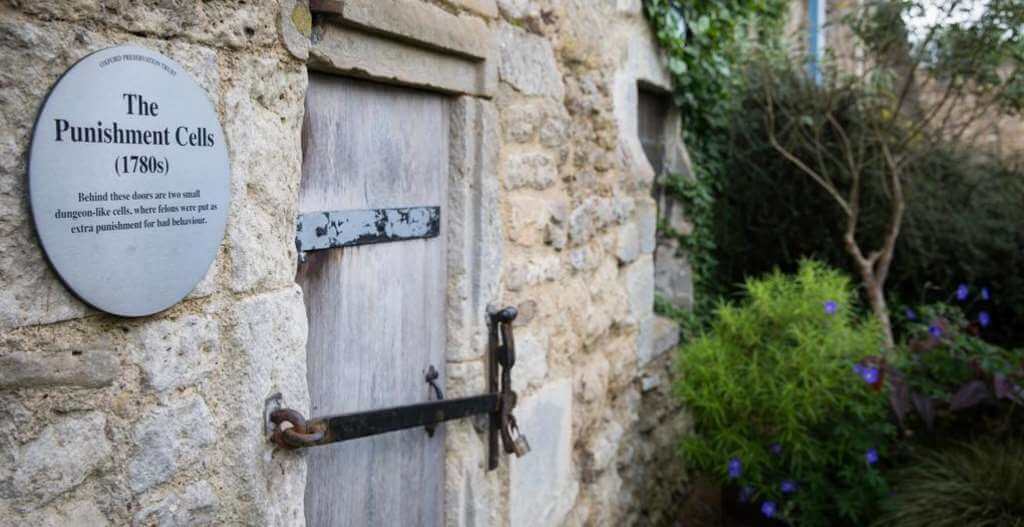
The Top 4 Prison Hotels
Ello, ‘ello, ‘ello. Fancy a short break with a difference? If so then check out our top four picks for prison stays you won’t want to escape from!
Malmaison Oxford, Oxford Castle, 3 New Road, Oxford, Oxfordshire, OX1 1AY
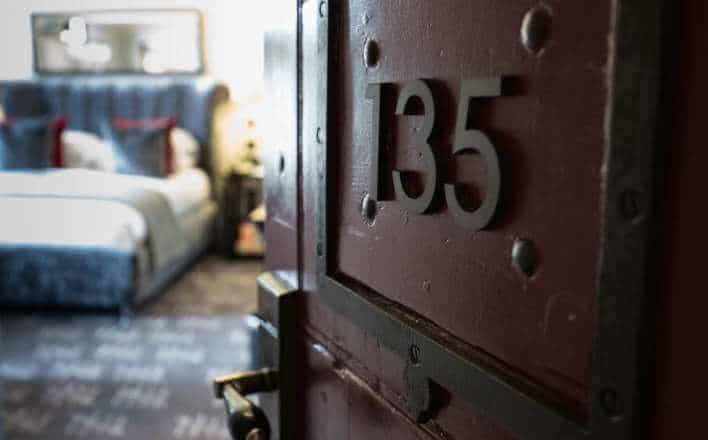
Located in Oxford City Centre, this boutique hotel is one of the most imaginative conversions in Britain. This luxurious hotel was once the ‘A’ Wing for the County Gaol in Oxford Castle, built in 1850s during the Victorian Gothic period and serving as HM Prison Oxford from 1888 until 1996. Today, the hotel combines luxury accommodation and stunning food with the darker past of the original building.
Open the heavy studded door to your cell and enter your boutique bedroom boasting luxurious beds and power showers. This is one jail that you won’t want to escape from.
Bodmin Jail Hotel, Scarlett’s Well Road, Bodmin, PL31 2PL
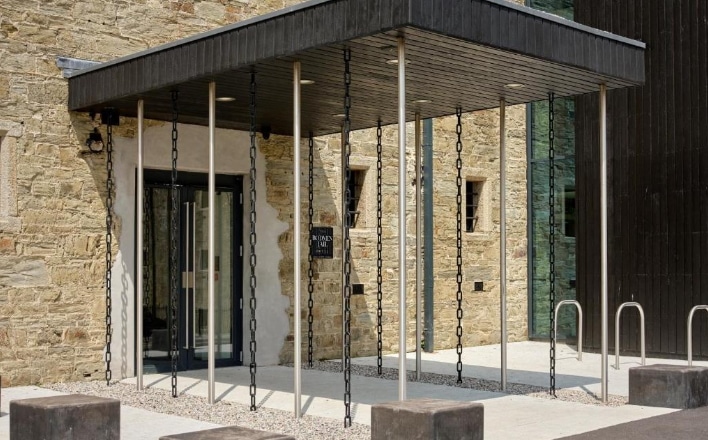
Features: Pet Friendly ~ Onsite Bar & Restaurant ~ Free Wifi ~ Family Rooms Available
Built in 1779 by prisoners of the Napoleonic Wars for King George III, Bodmin Jail is the site of 55 prisoner executions dating until 1909. Today, the gaol has been renovated from a dilapidated former jail into a boutique hotel.
Nestled in the heart of Cornwall, close to wild moor of Bodmin, Bodmin Jail Hotel is perfect for exploring Cornwall and all it has to offer.
Courthouse Hotel, 335-337 Old Street, Shoreditch, London EC1V 9LL

Dine in the building where Mick Jagger was once accused of being in possession of cannabis, or have a drink where Keith Richards received a £205 fine for possession of some illegal substances; The Courthouse Hotel in Shoreditch is steeped in history and has a connection to many famous names.
Having received a £40 million renovation, this luxury boutique hotel is located in a Grade-II listed Magistrates Court and Police Station and boasts a spa, bowling alley, cinema, swimming pool and a sky terrace overlooking London. It also boasts luxurious bedrooms and exceptional food.
How can you turn down a tipple in the cell where the notorious Kray twins appeared at their first criminal hearing in 1965?!
Good Hotel London, Royal Victoria Dock, Newham, London E16 1FA
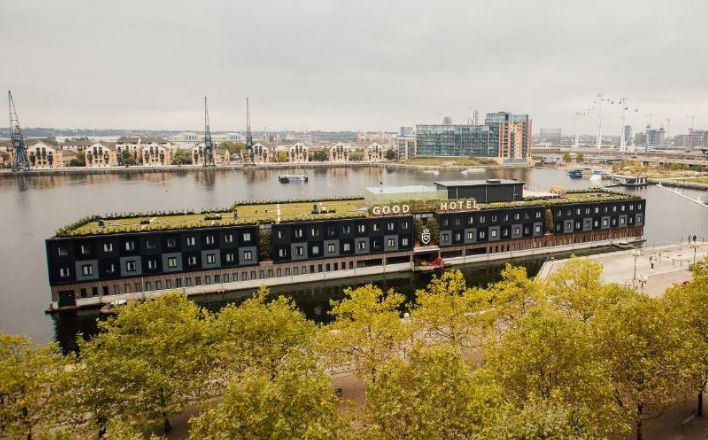
Just a short stroll from the ExCel Convention Centre and a few miles from London City Airport, and Canary Wharf, this former Dutch jail barge has now arrived in London’s Royal Victoria Dock, the city’s first long steamship dock.
Now a stylish floating hotel, it offers spectacular views of the River Thames and city beyond. All en suite rooms feature modern decor, with both custom-made and design furniture. Locally sourced food and drinks are served all day.
Popular searches
- Castle Hotels
- Coastal Cottages
- Cottages with Pools
- Kings and Queens

NIGHT BEHIND BARS - THE ULTIMATE SLEEPOVER

AXE THROWING - UNLEASH THE WARRIOR WITHIN
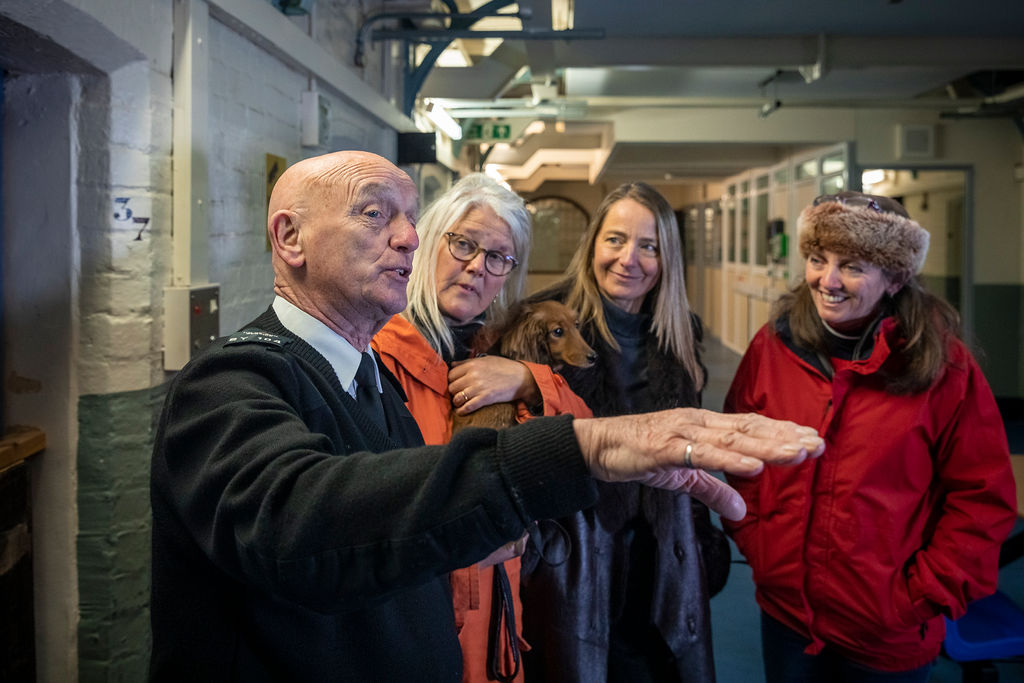
GUIDED TOURS - A FASCINATING NO-HOLDS-BARRED TOUR
As featured in

The Hole Escape Room
Join this fun filled, puzzle-based prison escape room as you try to outsmart the prison Governor and make your way to freedom. A Self-Guided Tour of the prison is included in the ticket price.
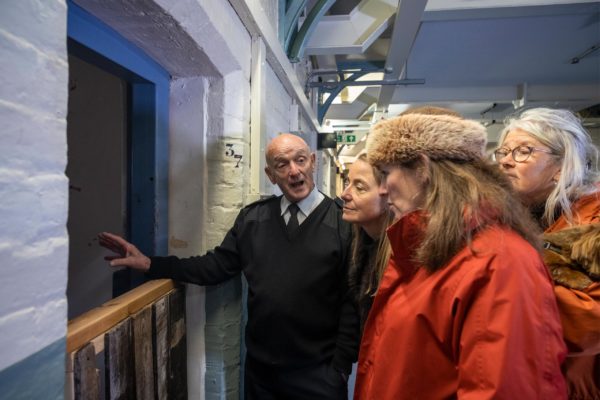
Guided Tour
A Prison Officer shines light on what life was like for prisoners. Bringing the prison to life through a no-holds-barred tour.
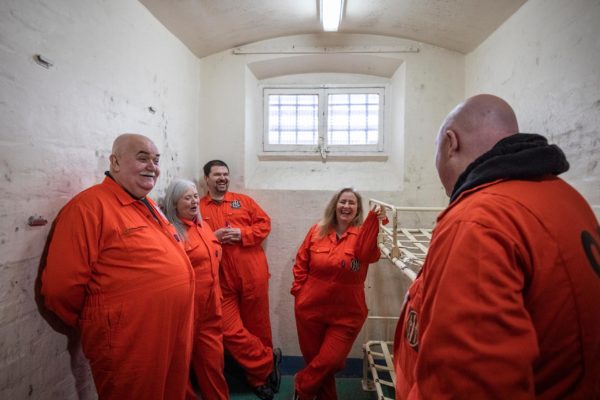
Prison Break
Prison Break: Put yourself to the test and see if you have what it takes to break out of a real prison in The World’s Largest Escape Game.
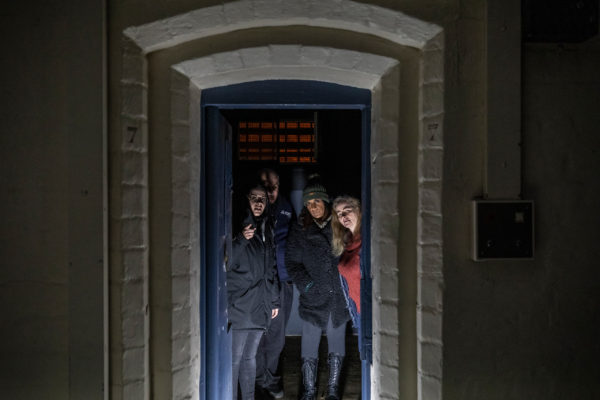
Paranormal Investigations Behind Bars
Connecting you with the paranormal happenings that go on within the prison.

The Cell Escape Room
Join this fun filled, puzzle-based game as you try to outsmart The Cell and make your way to freedom. A Self-Guided Tour of the prison is included in the ticket price.
NEWS & ARTICLES
Crimecon where true crime meets history.
Exciting news coming from Shrewsbury Prison as we announce a new partnership with CrimeCon UK, The world’s leading true crime event with their first event of the year held in Glasgow on 27th April. With a packed line-up of leading experts to discuss all things true crime, you’re not going to want to miss out! […]
Shrewsbury Prison's Easter Activities
Springtime is upon us, and what better way to celebrate the season of renewal and joy than with a thrilling adventure to Shrewsbury Prison? From 23rd March to 14th April, Shrewsbury Prison invites you to embark on a journey like no other with “The Great Eggscape,” an action-packed Easter promotion that promises fun for the […]
Email Signup
- I'd like to opt-in to receive updates, and offers. You can unsubscribe at any time.
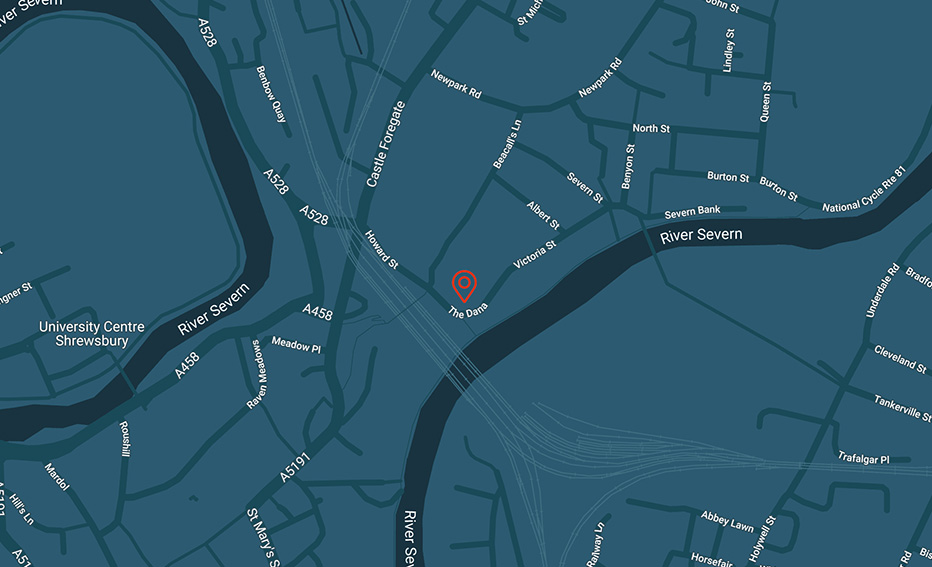
Opening Hours
Mon-Sun: 10am-5pm
Shrewsbury Prison The Dana Shrewsbury Shropshire SY1 2HP
© Copyright 2024 | Shrewsbury Prison is part of Cove Group Ltd.
Designed & Built by Reech

A VISIT TO DORCHESTER PRISON
Closed in 2013, Dorchester Prison is now awaiting its fate from developers, who will be turning the site into luxury flats. In the meantime, this historic Victorian prison is open for guided tours from a Prison Officer who worked there until it closed, providing a fascinating insight into the life of a county prison.

Dorchester Prison was once a focal point for the county town of Dorset, receiving men from the Crown and Magistrates Courts in Dorchester, Bournemouth and Poole, holding a mixture of both convicted and remanded prisoners. It was built in 1885 on the site of an older prison which had been built in 1796 and demolished around 1880, which in turn was constructed on the site of a castle from 1154.
Like many Victorian prisons, it was designed with wings radiating from a central area with galleried landings. Constructed in red brick with barred windows, towering chimneys, huge steel gates, razor wire everywhere and surrounded by a tall, thick wall, the prison is a relic from an outdated penal system.
While the building rots and rusts quietly as its future remains uncertain, the prison is open for guided tours, paranormal nights and combat games. I joined a tour yesterday on a bitterly cold January day, to have a look around.

Tours at Dorchester Prison are conducted by the very personable Ed who is still a serving Prison Officer in a nearby jail and who worked for ten years at Dorchester Prison before it closed.
On arrival you sit in a large room upstairs, all institutional sour-pink walls, overly bright plastic seating and sagging sofas, with corporate silver tea urns, waiting until the tour group is assembled.
Our tour had 29 people on it, a mixture of people who were fascinated by what lay behind the thick walls, a group of women with selfie sticks who I think had once worked there and even an ex-inmate who had spent some time there at Her Majesty's Pleasure.
Our tour started outside, where Ed stood on the steps and introduced himself while we stamped our feet and rubbed gloved hands in the ice cold air underneath a white sky filled with squealing seagulls. Behind us was a clock dating from the turn of the century framed by razor wire, the blue paint peeling and fading under a misshapen cover of lead flashing.
Ed took us around the grounds, a haphazard mixture of Victorian brick, modern extensions and rubble where buildings have been added and removed over the years, as well as recent archaeological excavations taking place in the grounds. Doors and gates led to various unspecified rooms many of which were workshops used for repairing things and which are part of the original 1885 buildings.

Ed stopped next to a blue shutter high on a wall and told us this was once the site of the hanging shed, until it was knocked down and replaced with modern kitchens.
Executions had taken place in public until the end of the 19th century when the appetite for them as a form of entertainment had waned with Victorian sensibilities. After that, executions had moved within the prison walls. Dorchester Prison had nine executions in the past 150 years, the youngest being a 15 year old who was hanged for arson.
At the time it was considered a 'cruel and unusual' punishment to make the condemned walk too long to the site of their execution; many prisons of the time would have the hanging shed right next to the cell. Here in Dorchester Prison, it was a two minute walk from cell to scaffold, which was considered too long. The hanging shed was last used in 1941.

Our walk took us to the exercise yard, a grey concrete square surrounded by grey walls, grey razor wire with two stone benches and a grey pole. Ed explained that the pole used to hold up a net, erected to catch contraband that people on the outside would throw in for the inmates, sometimes hidden in tennis balls. The yard was oppressive with its many shades of grey under the bleak grey, icy sky. Next to it was a smaller space which was used for those in solitary confinement, as they were only allowed to exercise on their own.

There is razor wire everywhere, its dull coils over every wall, gate and surface. Ed told us that type of razor wire is actually illegal in the UK, the only places that are allowed it are prisons who have to pay an annual fine to the government, who actually manufacture it.
Our tour was interspersed with several anecdotes like these, and you can sense the despair at the shambolic bureaucracy which surrounds the prison service. Another example was how items that needed fixing and repair used to be dealt with in the prison workshops - the item would be back to new in an hour or so. After the government's centralisation policy, it could then take weeks for something to be fixed. Similarly, Dorchester used to have its own laundry but that was also centralised, with items being sent off site for cleaning within a central cluster. They would send off hundreds of uniforms, sheets, everything and they would rarely get the same laundry back - one time they sent off a full load of items and got back a single hamper of just socks.
The prison had £41 million spent on it in the 12 years up to 2013, with a brand new healthcare section built just six months before it closed. The waste of taxpayer money was shocking.

Our tour then moved indoors and if we were expecting it to warm up, we were bitterly disappointed. The chill wind may have gone, but there was no warmth within those walls, something the prisoners would apparently often complain about.
Ed took us into the reception room where he talked us through what would happen if we were new prisoners arriving at the prison. He explained the process - how a prisoner would have his clothing removed one piece at a time with each item listed down, and each time be replaced with a piece of prison clothing. Their valuable items would also be itemised and removed, with inmates given one minute to write down all the mobile numbers from their phone that they might want access to during their stay, before they had to hand the phone over which they would not see again until they were released. There were healthcare checks followed by a photo and a prison number. Since 2009 a prisoner can keep the same prison number if they 'choose to make a career of it'; before that they had a different number for each time in prison which could get confusing for all involved.
They get asked dietary requirements as all diets are catered for, given their sheets, bowls, cleaning kits and other necessities before they walk to the centre of the jail with everyone watching from the cells above. It was easy to imagine the fear that many must have felt as we walked into the bottom of that chilly atrium.
The central hub from which the wings emanate is oppressive - high ceilings with bars everywhere we walked; narrow stairs and narrow landings surrounded by rusting bars, there was no need for suicide nets here as even the bars had bars.

We wandered through the landings peering into the cells which were all tiny, with institutional blue, yellow and green paint peeling off the walls in sheets, the black mould spreading across the rooms, the stainless steel loos and sinks, rusting sagging bunk beds and all with just a single pipe running across the back wall, which was their only source of heating.
Ed often mentioned the cold, how the punishment cells were so freezing that they were unbearable and some inmates would have to spend 12 hours in them. We stood there in our frozen group all in coats but still shivering and it was hard to imagine having to live like that.
We went into the chapel, a modern room with artificially bright blue walls and a red glass cross in the window behind bars. The prison service had to provide a minister for the religions of all inmates - even Jedi which is a recognised religion in the prison service. The chapel was used for meetings and all sorts of other events as well as religious purposes.
It was here in 2013 where staff were informed that the prison was closing. They were all very upset, being told that "every jail has its sell by date and you’ve reached yours". Several prisons across the country were closed in one go, saving the Ministry of Justice £3.8 billion from their budget, but leaving the prison service in freefall. The service is still understaffed by 10,000 officers.

We visited the Healthcare Wing where there were pharmacies and medical rooms. It is here where the ghost of Martha Brown is believed to be. As Ed was telling us a few stories of the various hauntings, he slammed shut one of the metal doors, and we all jumped in shock as the noise echoed throughout the empty rooms and corridors.
I found it fascinating to hear from a serving prison officer. I have no knowledge of the prison system, any information I have is from TV shows and films, so I was surprised how humane the officers seem to be - I imagined them to be brutal and uncaring, but as Ed was telling us about it all, giving us his thoughts on the injustices often meted out to them, I was surprised by his obvious sympathy. Researching this prison I found a website where ex-inmates were saying how they looked back on their time in Dorchester with some fondness, even using the phrase that they were 'good times'. The ex-inmate on the tour held no rancour and was happily discussing past times with Ed and the other people in the group. It reminded me again that the real world is often a far cry from how it is portrayed in fiction.
The tour was excellent - enlightening, fascinating and educational and is one I highly recommend before the prison is turned into flats and the chance is lost forever.
Visiting Dorchester Prison
Book tickets (£15 each) on the Gloucester Prison tour website (they own both prisons)
The tour is about 90 minutes long
There is free parking on site, but the prison is very central and can easily be reached by train and bus with just a very short walk
Want to visit more old prisons? Try one of these 13 prisons you can visit in the UK
Related Posts
BISHOP'S CAUNDLE - HOME TO THE UK'S OLDEST WORKING POSTBOX (BUT A MOST UNWELCOMING PLACE TO VISIT)
MAX GATE: THOMAS HARDY'S VICTORIAN VILLA AND THE LADY IN THE ATTIC
A FREE DAY IN CHRISTCHURCH, DORSET
Comentarios
Accessibility Links

Why are there so many prisoners in England and Wales? The crisis explained
More than 87,000 people are serving prison sentences, and the numbers are growing. but plans to cut the numbers being jailed may have little impact.

P rison reform can be a tough sell to the public. Just ask Marc Conway, the convicted burglar who tackled the terrorist Usman Khan during the Fishmongers’ Hall attack at London Bridge in 2019. Despite his heroics that day, he was still made to feel like a “second-class citizen” afterwards.
“No politician in their right mind would start lowering sentences,” admitted Conway, 43, who now works for the prison reform company Fair Justice.
Britain’s prisons are in radical need of reform. More than 87,000 people are in jail in England and Wales — one of the highest levels recorded — and the number could reach 115,000 by 2028, according to the Ministry of Justice. Staffing levels are critically low; some prisons are frequently forced into “red regimes” where prisoners are locked up for up to 23 hours a day.
Who is actually inside our jails — and why are their numbers growing so quickly?
Some 96 per cent of prisoners are men, according to the latest prison population data from the Ministry of Justice, while those in their late 20s and 30s are, statistically speaking, most likely to be behind bars. About a third are violent offenders, another fifth are in for sexual crimes and a sixth for drug offences.
Advertisement
The vast majority — 88 per cent — of prisoners are British nationals, but some other countries are more represented than others. Albania is the most common non-UK nationality, with 1,323 prisoners, followed by Poland (924), Romania (767) and Ireland (631).
Per capita, England and Wales (159 per 100,000) and Scotland (162) have some of the highest incarceration rates in western Europe.
In an attempt to avert a full-blown crisis, in October last year Alex Chalk, the justice secretary, promised a “fundamental shake-up of the justice system”, taking a two-pronged approach. Prison sentences of less than a year would be effectively scrapped , while rapists would stay locked up for the full length of their sentence.
Removing short-term sentences is hailed as a positive move by justice campaigners such as Pavan Dhaliwal, chief executive of the justice reform charity Revolving Doors.
More than 40,000 of the 68,000 people sent to prison in 2022 were given sentences of less than a year, the effect of which can be devastating to rehabilitation. “We know people who go into prison with mental health problems and come out a few months later with drug addictions,” she said.
Of those released after sentences of less than a year, 55 per cent go on to reoffend, compared with 22 per cent of those with longer sentences.
The move may slash the number of people being sent to prison.
Yet crucially, the figures suggest this will have a much smaller impact on the total prison population. Because they are in and out so quickly, those with sentences of less than a year make up just 4 per cent of the 88,000 people in English and Welsh jails.
Instead, a number of other factors have caused the prison capacity crisis.
One is chronically slow sentencing. Because of delays in the criminal justice system, the number of people awaiting trial in prison “on remand” has risen from 8,788 five years ago to 16,002 today, or almost a fifth of the entire prison population.
Many of these people, Dhaliwal pointed out, are either found to be innocent or are low-level offenders who do not end up receiving a lengthy sentence.
• What is the Times Crime and Justice Commission? Its aims explained
Another factor is the growing number of people serving time on “recall”. This is when people are let out of prison before their full sentence is up — a very common occurrence — but then recalled to prison because they have breached their release conditions. In just five years the number on recall has risen from 6,965 to 12,068.
Crucially, in most cases, this is not because they committed further crimes, according to a report by Justin Russell, the former chief inspector of probation. “Most recalls to prison were for non-compliance with licence conditions, resulting from homelessness, relapse into substance misuse, and a lack of continuity of care between pre- and post-release service provision,” he said.
Between them, prisoners on remand and recall make up a third of the prison population.
But another factor is quietly driving the overcrowding. Since 2000, the typical prison sentence has doubled, from 11 months to 22 months, with the biggest increases among serious crimes.
This runs counter to recent trends in other European countries. The Netherlands has cut its prison population so substantially that old prisons are being converted into schools and refugee centres.
At the extreme end, England and Wales had 65 prisoners serving “whole-life” sentences as of last June — one of the highest rates in Europe. In 1983 the figure was one.
In Norway, which has one of the best prisoner rehabilitation rates in the world, there are none. Not even the neo-Nazi mass murderer Anders Breivik, who killed 77 people in 2011 in the country’s worst terrorist attack. He was jailed for 21 years.
The appeal of “throwing away the key” is hard to ignore, especially for victims of the worst crimes. After all, the small number of whole-life sentences — corresponding to less than 0.1 per cent of all prisoners — is hardly responsible for the latest prison capacity crisis.
Most long-term prisoners used to be eligible for release soon after they reached the halfway point in their sentence, for example. But in 2019 the Conservative Party won a landslide election victory on a manifesto that included a commitment to “end automatic halfway release from prison for serious crimes”.
This is in keeping with public opinion. Last year the pollster JL Partners asked 2,018 UK adults whether they thought certain crimes deserved prison sentences. The public, it turns out, are tougher judges than the judges themselves.
Some 88 per cent of people think convicted arsonists should be jailed. The reality, according to Ministry of Justice data, is just 45 per cent. About 77 per cent want stalkers jailed; in practice it is just 44 per cent.
If judges impose community sentences instead of short spells in prison, said Dhaliwal, it could save tens of thousands of people a year from the deteriorating effects of prison — provided it comes with the right care to stop prisoners reoffending. However, it will barely make a dent in the actual number of occupied prison cells. Easing the capacity crisis requires something much harder.
Usman Khan, the terrorist tackled by Conway on London Bridge, was also meant to be speaking at Fishmongers’ Hall as an example of a successful rehabilitated prisoner — an irony not lost on Conway.
“The majority of people on that programme had committed a lot of crimes in their past but hadn’t offended since. But that’s all been washed over by Usman Khan.”
The Times Crime and Justice Commission , a year-long inquiry, will gather evidence from across the criminal justice system and will draw up a blueprint for far-reaching reforms.
Related articles

Prisoners could be released up to 70 days early to ease overcrowding
- Published 12 hours ago
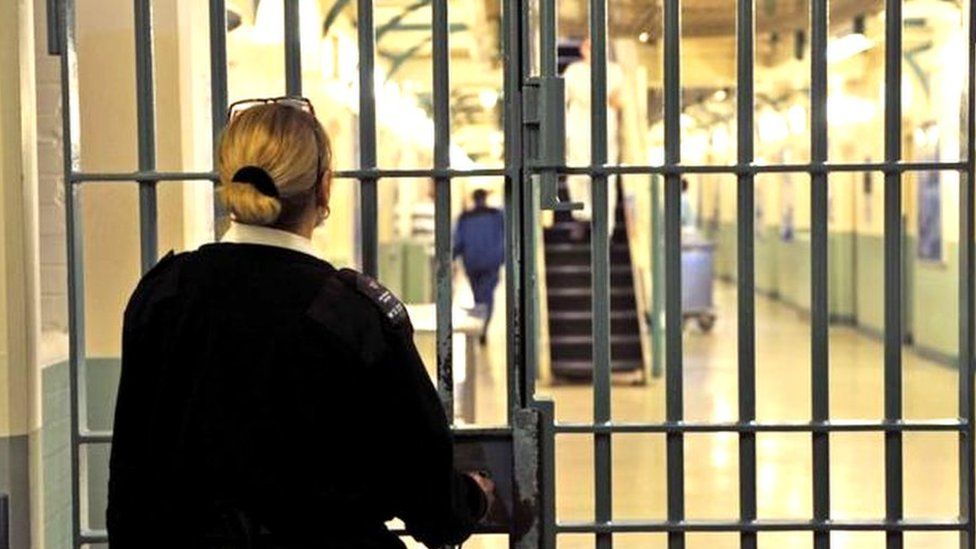
Some prisoners will be freed up to 70 days early, after a scheme aimed at tackling overcrowding in jails in England and Wales was extended.
The scheme was introduced last October, at the time allowing for release up to 18 days early, with this increased to up to 60 days in March .
Justice Minister Edward Argar said only offenders near release are considered.
But Labour claimed the early release scheme is the price the public pays for a justice system in "crisis".
Anyone convicted of a sexual, terrorist or serious violent offence is excluded.
Shadow justice secretary Shabana Mahmood tabled an urgent question on the issue in Parliament, after there was no formal announcement on the extension, first revealed by the Times .
Addressing MPs, Justice Minister Edward Argar said: "Many members of this house would be concerned about early release of offenders into the community, but let me be clear that only offenders who would soon be released anyway would be considered."
He added public safety "will always be our number one priority" and all those released would be subject to supervision.
Domestic abuse commissioner for England and Wales Nicole Jacobs said "there has been no consultation" about the changes and "victims' groups were not even made aware" before their introduction.
And Labour accused the government of extending the early release scheme - formally called the End of Custody Supervised Licence (ECSL) - in secret.
"Never in this country has a government ever been forced to release prisoners over two months early," Ms Mahmood told MPs.
Questioning the minister, she asked why the scheme had been increased to 70 days, how many prisoners had been released under the wider scheme and if probation would be given time to assess risk.
Mr Argar answered it was an "appropriate operational decision" to ensure courts have spaces to send people to prison.
Ministers have previously said the scheme was "targeted" and "operating in prisons as required and where necessary".
The change will take effect from 23 May.
'Simply isn't enough space'
Ms Jacobs said perpetrators of domestic abuse "frequently receive short prison sentences" and were "likely to be among those released early".
"The government needs a safe and planned approach. Instead they are letting potentially dangerous perpetrators out earlier and earlier with little oversight or evaluation of the scheme," she said.
"We need a specific exemption of perpetrators of domestic abuse and stalking."
The prison population has ballooned in recent decades as a result of tougher sentences and court backlogs.
At the beginning of this month the prison population stood at 87,505, with the total usable capacity at 88,895.
The figure is up from 84,772 a year ago, while capacity has increased by around 3,000 places.
Chief inspector of prisons Charlie Taylor said "there simply isn't enough space" despite "frantic" attempts to increase capacity with temporary accommodation and two new prisons.
"The number of places simply can't keep pace with the number of people coming in," he told Times Radio.
A Ministry of Justice spokesperson said: "We will always ensure there is enough capacity to keep dangerous offenders behind bars.
"We are carrying out the biggest prison expansion programme in a hundred years, opening up 20,000 modern places, and ramping up work to remove foreign national offenders."
The spokesperson said offenders would continue to be supervised under conditions such as tagging and curfews.
Related Topics
- Ministry of Justice
Prisoners could be released up to two months early
- Published 12 March

- International edition
- Australia edition
- Europe edition

Prisons ‘sleepwalking into crisis’ as inmates forced to share single cells
Longer sentences and court backlogs push 25% of prisoners in England and Wales into shared cells, adding to drug-use and violence
The scale of the prison overcrowding crisis has been laid bare by figures revealing that a quarter of prisoners in England and Wales have been sharing cells designed for one person with at least one other inmate.
According to the Ministry of Justice (MoJ), 11,018 cells intended for single use were being shared by two prisoners, with a further 18 such cells shared by three inmates. The overall prison population – which has ballooned over recent decades because of longer sentences and court backlogs – stood at about 88,000 when the statistics were originally compiled in late February.
Steve Gillan, the head of the Prison Officers Association, said sharing cells designed for one person creates tension among inmates, making the jobs of overworked prison staff even more difficult: “It is no wonder that the prison service is struggling to retain prison officers and operational support grades in England and Wales. The pressure on staff is intolerable and dangerous.”
He warned that the government was “sleepwalking into another crisis” after it “learned nothing” from the landmark Woolf report into the 1990 Strangeways riots, in which two people died. Among the report’s recommendations was that no prison should hold more inmates than is provided for in its certified accommodation level – which represents the “good, decent standard of accommodation” that the Prison Service says it aspires to provide to all inmates.
But three in five prisons are now overcrowded, with the problem most acute in inner-city Victorian reception jails such as Leeds, Bristol and Bedford, according to Charlie Taylor, the chief inspector of prisons.
Taylor said a lot of maintenance work is deferred in order to keep cells in use, and that too many prisoners have poor access to education and employment – activities that can reduce the chance of reoffending on release.
He believes that sharing is not inherently problematic, and can be a “protective factor against self-harm”, but is critical of the length of time many inmates are continuing to be confined in their cells, as they were during the pandemic. “The key issue is the conditions in which people are sharing cells,” Taylor said. “If prisoners were out of their cells spending the majority of their day in education and employment, then cramped conditions, while not ideal, would be less concerning. But the reality in many jails is two men spending up to 23 hours a day penned into a very small cell that was designed for one person, often in a poor state of repair and with an unscreened toilet. When you consider that, it is hardly surprising that levels of violence are rising and that we are seeing a worrying rise in the use of drugs,” said Taylor.
Prison Service rules require that cells are only shared where a prison group director has assessed them to be of an adequate size, condition and safety. Risk assessments are carried out on prisoners before deciding whether it is safe for them to share cells in closed conditions. Even a small oversight can lead to a vulnerable inmate being trapped with a potentially violent prisoner.
“We do complete risk assessments in custody but sadly on occasions there are times where people don’t get on. We would identify vulnerability, and those people get marked up to a single cell,” Mark Icke, the vice-president of the Prison Governors’ Association, said.
With many prisons at breaking point, the government has adopted emergency measures, including allowing some offenders to be released early , to try to tackle the overcrowding crisis. But the prison population is still projected to increase to between 94,600 and 114,800 by March 2028, in part because of a growth in police charging and changes in policy to keep the most serious offenders locked up for longer.
after newsletter promotion
Andrea Coomber KC, chief executive of the Howard League for Penal Reform charity, said sentencing reform is vital to create a more humane and sustainable justice system. “The government needs to take a serious look at other options and fundamentally reconsider sentencing regimes, which have meant sentences have gotten longer and longer over the last 20 years,” she said. “Nearly 40% of prisoners are there for non-violent offences. As a starting point, we need to think if any of those people need to be in prison at all.”
An MoJ spokesperson said: “We are delivering the biggest prison expansion since the Victorian era – including two prisons in two years – to help rehabilitate offenders and keep our streets safe. We will always ensure there is enough capacity to serve the outcome of the courts and keep dangerous offenders behind bars, and cells are only doubled up where it is safe to do so.
“Our sentencing bill will help reduce reoffending through greater use of tougher community sentences.”
- Prisons and probation
- The Observer
- UK criminal justice
Most viewed
Ukraine war latest: 'Undeclared Russian military intelligence officer' expelled from UK
The Home Office has expelled a Russian defence attaché as part of a series of measures against Moscow. James Cleverly said the attaché was an "undeclared military intelligence officer". Ask our military analysts or international correspondents a question in the box below.
Wednesday 8 May 2024 20:00, UK
- Home Office expels Russian diplomat who was 'undeclared military intelligence officer'
- Moscow 'developing nuclear power plant' for joint moon base with China
- Russia hits power facility and other energy infrastructure in massive overnight attack
- Dominic Waghorn: Russia may have crossed the line - but UK move to expel attache increases risk of dangerous escalation
- Ivor Bennett analysis: Painted as a modern-day Tsar, Putin seems more confident than ever
- Ed Conway : Russian oil still seeping into UK - the reasons why sanctions are not working
- Live reporting by Ollie Cooper
Ask a question or make a comment
Thanks for following our live coverage, we'll be back soon with more live updates.
Kosovo's foreign minister has said her country is convinced Russia must lose the war in Ukraine for conflict not to spread further in Europe.
Donika Gervalla-Schwarz said her young nation's support for Ukraine was unconditional - despite Kyiv not having recognised Kosovo's independence.
Ms Gervalla-Schwarzd her small Balkan nation, which declared its independence from Serbia in 2008, is repeatedly reminded of the aggressive intentions of both Serbia and its ally Russia.
"Ukraine hasn't recognised the Republic of Kosovo as a state, but we really believe that we know exactly what Ukraine is going through," she told The Associated Press in an interview.
"And we know that there is only one solution, not only for Ukraine, but for Europe," she said.
"It can only be Russia to lose the war and Ukraine to win this war. Otherwise, Europe should prepare for other conflicts in our continent."
The people of Kosovo were the targets of war crimes and other atrocities by Serbia's security forces in the 1990s, an experience that led Kosovo to seek independence.
"While Kosovo is a small state with very modest possibilities to help, we have tried to be very helpful with Ukraine and have not hesitated to show our unconditional support and sympathy to the people and to the state of Ukraine," Ms Gervalla-Schwarz said.
Lord Cameron has called the UK's measures on a Russian defence attache "an unequivocal message" to Moscow.
The foreign secretary was replying to James Cleverly's post on X in which he said the Home Office expelled a Russian defence attache as part of a series of measures against the country.
Other measures in the package include removing the diplomatic premises status from several Russian owned properties in the UK and capping the amount of time Russian diplomats can spend in the UK.
Budapest is once again raising eyebrows across the world's biggest military alliance as it pledges to defy a NATO initiative.
The alliance's long-term plan to support Ukraine militarily was agreed in April, but was dubbed a "crazy mission" by Hungary's foreign minister today.
Under the plans, NATO would take over some coordination work from a US-led coalition known as the Ramstein group.
Discussing the plans today, Peter Szijjarto said: "Hungary will stay out of NATO's crazy mission despite all the pressure."
Relations between Budapest and NATO have soured because of Hungary's foot-dragging over the ratification of Sweden's NATO accession - finally passed by Budapest in March - and also over nationalist Prime Minister Viktor Orban's close ties with Moscow.
The Russian embassy in London has said there will be "an appropriate response" after Britain expelled a Russian defence attache.
The embassy said the restrictions that had been imposed were done under a "groundless and ridiculous pretext", according to Russian state news agency TASS.
It comes after Russian foreign ministry spokeswoman Maria Zakharova was reported as telling journalists that the Kremlin will respond appropriately following the expulsion.
Dominic Waghorn, international affairs editor
It's always assumed defence attaches play some kind of role gatherling intelligence and that is generally tolerated by their host countries.
They could be gathering data about weapons production for instance or ship building but there is a line they are expected not to cross.
The assumption here is that the Russians have broken the rules of the game.
But the British government will have thought long and hard before expelling the Russian. It doesn't come without cost.
In their day jobs defence attaches play a crucial role in liaising with their hosts. That can be very important in terms of avoiding misunderstandings that could lead to unnecessary and dangerous escalation.
Losing Russia’s defence attache in London deprives the UK of one more line of liaison at a time when clear understanding and clarification could be essential to avoiding deepening conflict.
That is not ideal at a time of war.
What is not clear is how much these moves are connected specifically to the conduct of the Russians involved or should they actually be seen more as another chapter in the diplomatic war underway between Russia and the UK.
The UK has undoubtedly weakened Russia's ability to spy in the UK and gather intelligence but these measures will also affect Britain's ability to predict and avoid potential escalation.
That will be made even worse if Russia, as may be expected, responds with like-for-like retaliation
Seven people have been injured by Russian shelling in eastern Kharkiv, according to the region's governor.
Oleg Synegubov said among those wounded was an eight-year-old girl and three boys, two aged 14 and the other 15.
"Two [of the] boys are in serious condition, [the other] boy and [the] girl are in average condition," he said.
One 55-year-old civilian of unspecified gender was also hospitalised.
Two women had minor injuries.
Defence Secretary Grant Shapps has offered his thoughts on the expulsion of a Russian defence attache the government has accused of being an undeclared military intelligence officer.
"Today we've expelled Russia's defence attache who has been working as an intelligence officer for Putin in the UK," he said on X.
"We will not tolerate Putin’s efforts to undermine our nation and democracy and will continue to stand up for freedom here and in Ukraine."
Each week we ask readers for their questions on the war for our military analysts and international correspondents.
This week, military analyst Sean Bell answers:
Why is Ukraine focusing its drone attacks on oil refineries rather than near the front lines? Mike
Thanks, Mike, for this topical question.
Although the ultimate metric of success in this brutal war is territory gained, to achieve that outcome requires a more complex strategy than simply focusing on the frontline battle.
One of the reasons that the Royal Air Force was formed as an independent service was the recognition that greater impact could often be achieved by targeting enemy logistics and supply lines behind the frontline, rather than simply focusing effort on the "close battle".
Military action is ultimately driven by political will to achieve a desired end-state; the military simply creates the conditions in which a political outcome can be achieved.
At the tactical level of warfare, the focus is on the battles of individual soldiers and units prevailing against tactical targets.
However, at the other end of the spectrum, senior military strategists seek to attack the enemy's "centre of gravity" - the one thing that the enemy cannot afford to lose and thus must protect at all costs.
'Fight smarter'
In the Second World War, much of the Allied bombing effort was targeting German industrial capacity, as without the ability to regenerate military equipment and ammunition, the war would not be sustainable.
Ukraine has a smaller army than Russia, and so any conventional attritional battle would favour Russia.
Therefore, Ukraine has to try to "fight smarter" and erode Russia's will - or capacity - to fight.
A war on this scale consumes huge quantities of resource, which has to be funded in some way.
Russia's oil exports fund Vladimir Putin's military campaign and also pay for imports of vital munitions from North Korea and Iran.
By targeting the enemy's oil facilities Ukraine will be aiming to reduce Russia's export capacity, which in turn impacts Russia's ability to fund the war.
That might not help the close battle, but could undermine Russia's commitment to a longer-duration conflict.
And, although drones are an "irritation" to the frontline forces, the quantity of explosives they are able to deliver is relatively small, so their effect is relatively limited.
However, an oil facility is very vulnerable to a relatively small-scale explosion, which can spread swiftly to destroy a crucial part of Russia's critical national infrastructure - more bang per buck.
So, although Ukraine desperately needs to stop Russia from breaking through its frontlines, we can expect to see Ukraine continue to target energy infrastructure as part of a broader strategy in its war with Russia.
We now have more details regarding the freshly expelled Russian defence attache we reported on in our 1.10pm post.
The attache accused by the Home Office of being an undeclared military intelligence officer spying for the Kremlin is Colonel Maxim Elovik.
Be the first to get Breaking News
Install the Sky News app for free


IMAGES
VIDEO
COMMENTS
These 13 old prisons in the UK have opened their doors to visitors and put their grisly pasts on display. You can learn about the most notorious of criminals, the wrongfully imprisoned, the executed and the terrible conditions many of them lived and died in. Several of these prisons offer events such as ghost tours or even sleepovers in the cells.
Oxford Castle and Prison is over 1000 years old. It was built after the Norman invasion in 1066 by Norman baron Robert O'Doyly. Over time the Castle transformed from castle to a prison. It closed its doors to prisoners in 1996 and is now a tourist attraction. To get the best out of a visit to Oxford castle and prison, book a guided tour.
10 Historic Urban Prisons. by Allan Brodie. 18 May 2016. Comment 1. Here are 10 of England's urban prisons that help to tell the story of 250 years of imprisonment. 1. HMP Stafford. HMP Stafford was the brainchild of the pioneering prison architect William Blackburn. Begun in 1787, the original building consisted of a quadrangle with ...
WELCOME TO DARTMOOR PRISON MUSEUM. Visit us and learn about 'life inside' one of the world's most famous and notorious jails. Our museum attracts more than 35,000 visitors every year from all over the world. Some of the artefacts and documents on display will surprise you but will certainly enable you to form an opinion about prison life.
The Clink Prison dates back to 1144 making it one of England's oldest and most notorious prisons. Positioned in the heart of modern-day Southwark and built on the original site, The Clink Prison Museum presents the scandalous truth of Old Bankside through a hands-on educational experience. There are opportunities to view archaeological ...
ENGLAND - arranged by county: Buckingham Old Gaol Market Hill, Buckingham MK18 1JX. Tel:+44 (0)1280 823020. Open Mon-Sat 10am-4pm (last entry 3.30pm). ... Visit a prison designed to implement the 'separate' system with prisoners kept in separate cells fitted with a sink, toilet, hammock and equipment for labour. The chapel, with its partitioned ...
Read more about the history of London's prisons. Though the Victorian places no longer exist it is possible to visit the sites where they once stood, which will also take you into interesting areas of London. All for free, of course. It is possible to visit the Tower of London (admission charge). click to view map of historic prison locations.
Dates: Every Wednesday Times: 6:30pm & 8:30pm Duration: 1.5 hours Great for: Families, Ages 12+ Price: Adults £25, Children £25. Shrewsbury Prison is the 6th Dark Tourism Destination in the World - come and discover and hear the tales of what lurks behind the high prison walls in the dead of night. Find Out More.
Discover Littledean Jail and Museum of Crime in Littledean, England: A 200-year-old prison that now houses a peculiar crime museum. Trips. ... Visit Adventures. Trips Highlight.
Oxford Castle was originally a wooden motte and bailey castle.The wood was replaced by stone around the late 12th or early 13th century. Although Oxford Castle played a crucial role in the conflict of the Anarchy (a civil war in England and Normandy between 1138 and 1153), its military value decreased in the 14th century and the place became a prison and county administration building.
Inveraray. Argyll. From £0 per ticket. Step back almost two centuries and discover the stories of the real men, women and children who were tried and served their sentences in this prison.Listen to dramatic true tales from the Jail's characters brought to life with our FREE AUDIO GUIDES. Come and experience one of the finest and best preserved ...
Plan your Visit to the Old Prison in Northleach. ... Volunteer; Workshops; More... PLAN YOUR VISIT. There's lots to do in and around the Old Prison site, so get planning to make the most of your visit. Opening Times ... Local Walks | Walk around the Old Prison. Contact. 01451 860 339 [email protected] The Old Prison, Fosse Way, Northleach ...
The Old Prison. Where: at the Old Prison, Fosse Way, Northleach, Gloucestershire GL54 3JH. The grade II* listed Old Prison, is a fascinating 18th century building and now a unique historic visitor attraction in the Cotswold market town of Northleach. The centre was previously also home to the Cotswolds Conservation Board, and the Cotswolds Dry ...
The Cell Escape Room. Next availability: Today, 10:30am. The Cell Escape is a fully immersive, state-of-the-art escape room experience, where you get to do the time without committing the crime! Experience the pulse racing, mind-manipulating, adrenaline-charged rush of 'The Cell Escape Room'. Try an Escape Room.
To use this service you need the: If you do not have the prisoner's location or prisoner number, use the 'Find a prisoner' service. You can choose up to 3 dates and times you prefer. The ...
Visiting a prison isn't as scary as it sounds, they are a great way to learn about the history of wherever you are visiting. And in most cases, a towns' prison is often the epicenter of some of the best stories. Read on for the top prisons open to visitors in the UK: 6. Bodmin Jail, Cornwall.
A visit to The Old Prison offers you a unique glimpse into life in a 19th century House of Correction. Built-in the 1970s, this was once a fine example of a model prison used to inspire better care and rehabilitation of prisoners throughout Britain. ... His writing opened the eyes of the country to how dreadful the conditions were as well as ...
The Dana Prison closed in 2013 and is now called the Shrewsbury Prison. It provides visitors a unique glimpse into what life was like for inmates over the prison's 200-year history. Walking ...
If so then check out our top four picks for prison stays you won't want to escape from! Malmaison Oxford, Oxford Castle, 3 New Road, Oxford, Oxfordshire, OX1 1AY. Features: 4 Star AA Rated Hotel ~ Rosette Awarded Restaurant ~ Dogs Welcome. Located in Oxford City Centre, this boutique hotel is one of the most imaginative conversions in Britain.
The Hole Escape Room. Next availability: Tomorrow, 10:30am. Join this fun filled, puzzle-based prison escape room as you try to outsmart the prison Governor and make your way to freedom. A Self-Guided Tour of the prison is included in the ticket price. Book Now.
A VISIT TO DORCHESTER PRISON. Closed in 2013, Dorchester Prison is now awaiting its fate from developers, who will be turning the site into luxury flats. In the meantime, this historic Victorian prison is open for guided tours from a Prison Officer who worked there until it closed, providing a fascinating insight into the life of a county prison.
Museums have been created from many former jails and prisons. Some old jails converted into museums are listed under the original name of the jail, especially if listed on the US National Register of Historic Places.For example, see Old St. Johns County Jail in St Augustine, Florida.. Museums with a main purpose not associated with the jail or prison [What is the difference between a jail (or ...
Prisons, prison services, prison population and prisoner categories England, Wales, Scotland and Northern Ireland. Public Sector prisons in England and Wales are managed by His Majesty's Prison Service (HMPS), which is part of the His Majesty's Prison and Probation Service, an executive agency of the United Kingdom government. In addition, since the 1990s the day-to-day running of a number of ...
The vast majority — 88 per cent — of prisoners are British nationals, but some other countries are more represented than others. Albania is the most common non-UK nationality, with 1,323 ...
Some prisoners will be freed up to 70 days early, after a scheme aimed at tackling overcrowding in jails in England and Wales was extended. The scheme was introduced last October, at the time ...
Longer sentences and court backlogs push 25% of prisoners in England and Wales into shared cells, adding to drug-use and violence The scale of the prison overcrowding crisis has been laid bare by ...
Oleg Synegubov said among those wounded was an eight-year-old girl and three boys, two aged 14 and the other 15. "Two [of the] boys are in serious condition, [the other] boy and [the] girl are in ...